#or rather like... the concept/trope that she represents i guess
Text
I love collei so much but it should be noted. the collei that I love is the completely fake ideal version of her that only exists inside of my head
#well and lee's too. tbh#being completely honest i think i would actually dislike collei had i not read the webtoon#not for any serious reason its just that her portrayal in the game is like... very two dimensional i guess#she just comes across a very palatably shy cute girl yknow.. not to mention how her eleazar is treated#it just so happened that i got attached to her so my anger got redirected#towards hoyoverse as a whole for writing her like that#but initially it was like.. directed towards her as a character i was very neutral on the cusp of being annoyed by her#or rather like... the concept/trope that she represents i guess#all of the things that make collei so interesting to me are practically nonexistant in the game#(for now) im hoping the rest of windblume continues to expand upon her character#but also id be pretty disappointed if the extent of what they do with her is just... she doesnt want to be shy#which is like. Fine i dont think its horrible#but one of the primary things that make her such an interesting character to me is her anger#how it was the only emotion she let herself feel for a long time and howit was the one constant she could rely on#in a world that she principally not trust out of survival#and now that she doesnt want to be angry anymore shes at a loss at how to fill the void#because its so much easier to be angry than it is to be anything else#i think the concept of her struggling to become a kinder person is Soooooo vastly interesting and adds so much more to her character#but unfortunately thats all stuff that only exists in my head. and i doubt it will get much mention in the game#even with windblume happening#colleiction
16 notes
·
View notes
Link
For Press, a forward for the US women’s national football team, building a collection around video games has posed a learning curve. When our creative director presented the idea, I was like, no, I don’t play video games. [Laughs] I don’t like this concept, bring me something else! she remembers. A year later, here we are with the Gamer collection. So you can see how this [debate] went.
The Spring collection, awash with a gamer-meets-raver vibe, most directly reflects the creative director of Heath reincs and one of USWNT’s resident gamers, according to Press. There is a bit of a connection between athletes and the games, Press adds. It’s a way that a lot of [our teammates] likes to decompress while playing FIFA, or Zelda.
Ultimately, the motif of the game works as an extended metaphor, depicting genre dynamics that are anything but imaginary. The larger idea we wanted to get across was the similarities between what we experience as athletes, with our own fight for gender equality, Press says. Indeed, it is difficult not to read the allegory in the Gamer collection: like the fictional past designed to accompany him, four queens must fight to progress in a gamified realm, weaving their way through Mt. Steadfast and challenging a resentful group of Overlords.
For Spring, they opted for cubic graphic fonts and heavily Web 1.0 hues, as well as analog gear (skateboards) and knickknacks (playing cards). More than a cultural homage, the nostalgia-tech aesthetic allows for a sort of corrective, albeit an historic, fantasy. Example: Gamer playing cards, in which kings, jacks and aces are replaced by you guessed queens. There are only queens in this deck, and you can assign their value, Press says of the updates, each inspired by one of the four founders of reincarnation. The idea [is that] Playing card structures are steeped in sexism, so we wanted to do away with that.
As Queens v. Mt. Regular plot, they also wanted to reverse the gendered video game tropes. By searching [for the collection], every video game I’ve come across seemed [center on] a woman in peril. Like, the idea that Mario is going to save Princess Peach, Press observes. You don’t have to be a gamer to see how very outdated this is, in my opinion.
For Press, research on games has only reaffirmed just how intractable systemic sexism really is. Much of what I experience as a woman is microaggression, which you don’t necessarily notice right now, she says. But in video games, it’s actually so obvious and blatant … Because the arguments we [athletes] hearing that men are physically stronger than women [dont apply]. So the fact that women are also under-represented in the video game space proves to me once again how irrelevant arguments like these are. Everything is societal.
These hard-won ideas are implicit in the relentless campaign against inequality. But so is the enduring possibility of change, as indicated by the grassroots causes. These include voting rights, migrant rights and the distribution of PPE, in addition to this season’s partnership with Black Girls Code. When you look at who makes the games, and more generally in industries based on math and science, you see the problem, Press says. That there is no diversity of thought in these spaces, which is the case for a reason. It was the status quo that was difficult.
With his new tech buff, will Press ever join his teammates on the virtual playing field? Unlikely: we’re at FIFA, so [I get why] many like to play FIFA, she says. But I think it would be weird. I can’t even watch movies where someone is playing football [Id rather be] with Mother Nature.
155 notes
·
View notes
Text
Asian drama female lead passivity
I feel like a lot of aspects of female lead (FL) passivity is discussed (the fish kiss being the most famous example), but I wanted to systematically analyze each trope under the theory of female passivity and its feminist implications.
This topic has been stuck in my mind ever since I read a blog years ago (literally like six years ago so I’m sorry I have no idea where it is, I can’t link it) talking about how intimacy in Asian dramas is always portrayed as something women relent to giving up half-heartedly, and men one sidedly pursue. Women are chaste, men are lustful, and women are yielding to men, that is the essential message.

This dynamic plays out in Western media as well--the movie Don Jon is a super interesting analysis comparing how women are indoctrinated by romcoms, to how men are indoctrinated by porn. So women attach grand romantic gestures and romantic commitment to their self worth, because that’s what the girl gets in her happy ending, while men attach it to sexual prowess/having women do kinky sexual favors.
This dynamic is super harmful because it works to suppress female sexuality, as well as male emotionality. People are always surprised when a woman would rather just want sex (or a career) over a romantic commitment. And men are applauded for having the bare minimum of emotional awareness because it’s so rare.
I think a form of Asian drama female lead (FL) passivity that is most talked about is the infamous “fish kiss.” See exhibit A:
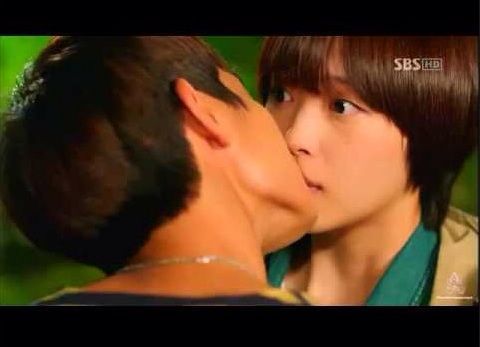
The guy initiates the kiss on the usually unsuspecting girl, as if the girl ever going in for the kiss herself would be too sexually aggressive. And as if even enjoying the kiss would be too much, they have her just stand there eyes wide open. It’s awkward, and even slightly funny to watch, but our critique often ends here. But I think the fish kiss is a symptom of a much deeper problem.
You will notice that female lead passivity is present in all physical interactions between the romantic interests.
The pull in hug:
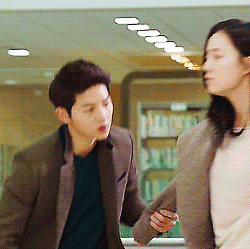
Which sometimes the FL looks uncomfortable to frightened in:

I even found a meme, so I know I’m not the only who thinks this is weird:

(meme/photo credit: https://goliath1357.tumblr.com/post/27115253892/kdramareasons-awkward-one-sided-hugs-k-drama)
What I don’t like about this trope is first of all, it makes female consent seem less romantic. It romanticizes this idea of male pursuit/female passivity, the man will protect her, the man will pursue her (basically like an object), the man will do all the work in making the relationship progress, etc., and it romanticizes this dynamic to women--this is easy to romanticize for us, because to the most of us that aren’t being constantly pursued by two hot men, this pursuit dynamic seems like a dream boat. Often the kdrama female lead (due to the Initial Misunderstanding trope) will even dislike and push away the male lead--and yet he still pursues her, how romantic! -_- Except in real life, the guy aggressively pursuing you and ignoring you disinterest is not romantic.
And the issue is on both sides, because it teaches women to just stand there, not express consent, and not express sexual/intimacy enthusiasm when we’re feeling it (that would be ~unladylike~). And on the other side, it teaches men to do all the pursuing and to assume that a girl standing frozen, wide eyed, and often looking scared as you kiss her, is consent. Sometimes the guy even interprets a clear “no” as consent. (Honestly I’m not even sure if these Asian drama writers are thinking along the lines of “xyz is consent,”...like I’m not sure how often they even think of the concept of consent tbh.)
But anyways, passivity. is not. consent!!!! That’s why we have the slogan “Yes mean yes,” meaning both parties must have enthusiastic, clear consent, for respectful intimacy. Asian dramas discourage women from expressing an enthusiastic “yes,” and it teaches men not to expect this “yes,” so they can steamroll past passivity and even rejection.
And I know some people will be boohooing me on this. “But sudden kisses and hugs are so romantic!” people will say. But what is “romantic,” like many things, is a social construct. We think things are romantic because they’ve always been presented to us as romantic, with swelling music in the background and the implicit understanding that anything is ok because they are Soulmates(TM) that end up happy together. We construct our idea of what is romantic largely out of media.
But that is not real life, and carrying those messages over to real life (as we inevitably all do), is dangerous. I just moved to Japan so this especially hits close to home for me: I dress conservatively by American standards, but I couldn’t bring a quarter of my clothes when I moved because I worried men on trains would interpret them as revealing, and therefore I would be “asking for it.” I, and I’m sure many women will feel me on this, think about and fear sexual assault very often. And when we don’t enshrine active consent, we perpetuate rapist culture.
Since “romantic” is anything our society constructs it to be, let’s romanticize enthusiastic consent! (like this NCT song!!) I think sudden kisses can be cute when you’ve established boundaries that it’s is ok, but it scares me that men and women are watching this and thinking suddenly kissing a person you haven’t discussed boundaries/intimacy with at all is cute. It’s all fun and games when it’s the hot male lead kissing the girl you know he’s going to end up with, but it’s not cute when it’s real life men thinking they’re entitled to women’s bodies.
Other examples of female passivity:
I stopped watching Moonlight Drawn over the Clouds at precisely this scene:
https://www.youtube.com/watch?v=X6I0WXeD-dc&ab_channel=KBSWORLDTV
because it was so painful to watch her sitting there like a fish as the guys got these cool fight scenes. Like girllll literally do anything, throw a rock, something! First dramas routinely disable the female characters by making the male characters the able fighters, but even if you’re not an able fighter you can do more than just sit there like a lame duck -_- Especially the parts of these scenes where someone is standing over the girl with the sword and the writers don’t give the girl the presence of mind to simply run away, but they give the guy the presence of mind to somersault into the room, jump over ten monkey bars, slash the antagonist, and catch the girl bridal style on his way down. I guess the damsel in distress trope is as old as the book, but just the complete passivity so many female characters show in fight scenes as they need to be saved is really annoying and disempowering.
I think the worst part is their faces, they’re all like omg! this is so sad!
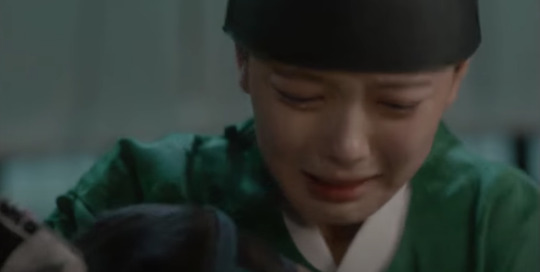
well girl you could have done literally ANYTHING other than sit there as he took ten bullets for you lmao. Women don’t exist to stand by and be saved!!! This is a historical drama but the modern drama version is when the guy is getting beat up by bullies or whatever and the girl just stands by and does nothing but look upset.
Another good trope that is under this passivity theme is the double wrist grab, where we not only have ONE male lead (ML) manhandling the FL, but TWO MLs. Ahh yes the only thing better than forcibly ignoring consent and the FL’s wishes is TWO men doing it.
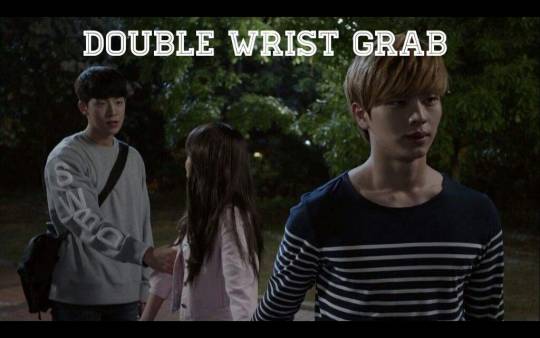

I heard this recently even happened in True Beauty...which...that drama...truly I thought Kdramas were progressing until I saw how much people were hyping up that mess of misogyny (not to mention how boringly predictable it was).
I can’t quite express this next trope in a screenshot, but something I also see a lot of is the ML professing his love to the FL and she sort of just stands there like O_O. Like she’s just sort of this object that sits there being admired? It’s just such an unnatural way to react to someone professing their love for you, and these scenes drag on for many minutes of just the ML’s dialogue so the female actress, having no lines, has no choice but to sit there O_O. Like give her lines! Give her reactions! Give her anything other than being wide eyed!!!!
And these physical interactions represent deeper emotional passivity in the female lead.
I’ve noticed it’s almost always the trend of the male lead falls later, but falls harder, and ultimately he puts more energy into making the relationship progress. Again, this buys into female fantasy, but it is an unhealthy fantasy that is grounded, I think, in our insecurities, and our fear of putting ourselves out there (so we would rather have someone pursue us than put ourselves out there and meet someone halfway).
This emotional passivity is why, weirdly enough, sometimes I will really like the drama because the girl is very stubbornly, openly, and aggressively pursuing the guy. A case of this is Itazura na Kiss, or Mischievous Kiss (there’s a Jdrama, Kdrama, and anime--I only watched the anime). Now the guy is downright meannnnn in Mischievous Kiss, this was not a healthy relationship at all, but there was something refreshing about the girl. Sure her aggression was in pursuing a man, but at least it was aggression, and I’d always only seen any hint of female sexuality/actively pursuing as something very stigmatized.
I think a sister trope to the passivity trope is the innocence trope. The guy will literally take the initiative to profess his undying love to the FL and she’ll be like “what?? omg stop teasing you’re joking ahahha.” Why do FLs need to be so oblivious/innocent? I think it caters to the way media is seen through a male gaze but that’s a trope to deconstruct another time.
65 notes
·
View notes
Note
Have you noticed the latest edition of Charlie Bowater can only draw one (1) face? She did The Princess Will Save You and Cast In Firelight both YA Fantasy set to be released this year. And they are how you say... the same fucking cover
Ah yes so you saw the same tweet I did

I know I literally just posted that we cannot outlaw book covers from looking like each other, but ! Oof!
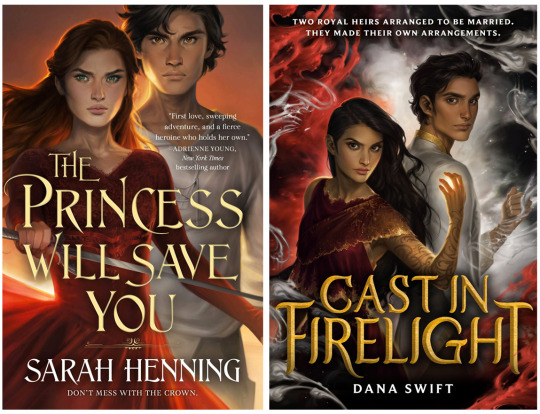

The only thing that softens the blow here is that Charlie has improved at representing nonwhite features such that characters look like POC rather than tan white people, although,, that bar was low. Anybody remember the ACOTAR coloring book.
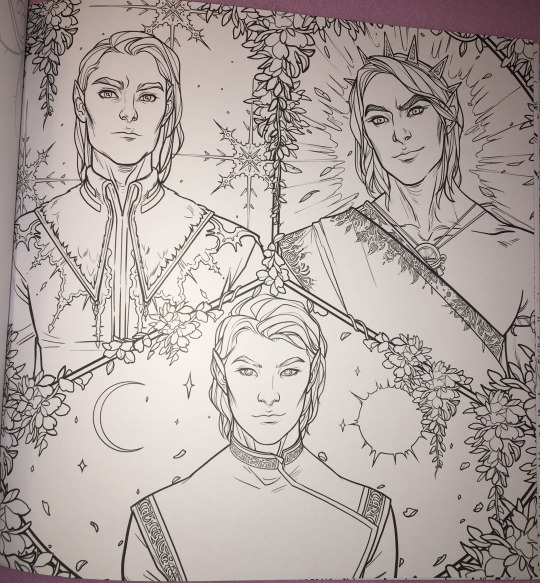
(Would you have guessed that 2/3 of these people are nonwhite? Or even that they’re supposed to be three different men? I guess all the men in Prythian have the same haircut?)
But that minor victory is mostly lost in the quagmires of the fact that Charlie’s style is to give everyone instagram face:
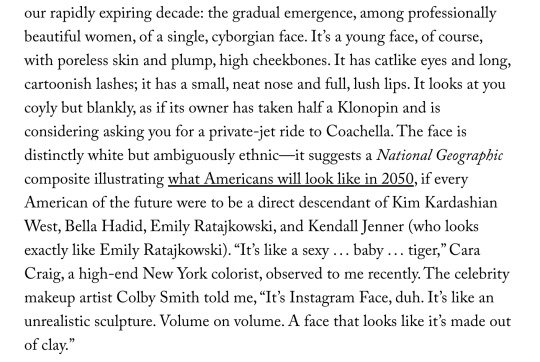
I wouldn’t even call this “Sameface” necessarily: that implies limitation, that an artist is only capable of drawing a single facial structure competently. Bowater is incredibly technically talented, she just chooses to give everyone catlike fae eyes and the cheekbones of a starving nymph. (My previous post on this here.)
But I don’t really blame her for that, or for these hilariously identical, nearly devoid of personality covers. Artists are allowed to do whatever they want. Artists who make art for covers are being art directed by designers and marketing teams who bear responsibility for how the finished pieces turn out.
No, this is our fault, as a community and an industry and..... society, kind of, for valuing character portraits that are “pretty” (“pretty” being an extremely loaded, culturally subjective concept) over art that actually Says Something About The Story. Bowater’s style happens to dovetail perfectly with what we currently collectively find pretty, and so we’ve put her art on a pedestal at the cost of everything else art can or should do for our stories.
And this is understandable: in contemporary western culture, pretty is a value unto itself. Seeing our characters portrayed as pretty denotes them as special, as smart, as powerful. It’s almost impossible to de-program ourselves from that reaction. There are approximately five kajillion studies on how beautiful people are at personal and professional advantages; how they’re perceived to be happier, healthier, more successful, and how those perceptions can translate into realities. (Nevermind how thinness and whiteness enter that equation, see above note about “pretty”.) I would love to see more “average” or weird- looking characters abound (and be accurately visually represented) in the YA/ Genre lit sphere, but for now... everyone is pretty.
Which sometimes means everyone is pretty boring.
But that’s just the specific, "What’s the deal with Bowater’s success in book circles and her style and all the sameiness” part of this equation. What if we backed up and asked: why character art at all? Beyond a question of “pretty”-ness (and general obvious Artistic Quality), why do we gravitate towards it, what's the purpose of it, how does it fall flat in a general sense, and how can it be utilized more effectively?
This is something I think about all the time. I follow writers on social media (because..... I am a writer on social media, regrettably), and we have an enormous collective boner for character art. “Getting fanart [of the characters]” is one of the achievement pinnacles constantly cited when people get or want to get published. Commissioning character art is something we reward ourselves with, or save up for (WHICH IS GOOD AND CORRECT. FREE ART IS GREAT BUT DO NOT SOLICIT IT. PAY YOUR ARTISTS). And like???? Same????? We love our stories because we’re invested in our characters. Most humans, even prose writers, are visual creatures to some extent, and no matter how happy we are with our text-based art, it’s exciting to see our creations exist in that form. So we turn that art into promo material and we advocate for it on our covers-- because it’s so meaningful to us! It goes with the story perfectly!! Look at my dumb beautiful children!!!!!
But on an emotional level, it’s hard to grasp that it only means something to us. Particularly when you take into account the aforementioned vast landscape of beautiful visual blandness of many characters (in the YA/ genre lit sphere, that’s pretty much all I’m ever talking about), character art can be like baby photos. If you know the baby, if that baby is your new niece or your friend’s kid, if you’ve held them and their parent texts you updates when they do cute shit, you’re probably excited to see that baby photo. But unless it’s exceptionally cute, a random stranger’s baby photo isn’t likely to invoke an emotional reaction other than “this is why I don’t get on facebook.”
Seeing art of characters they don’t know might intrigue a reader, but especially if the characters or art are unremarkable-looking, it’s doing a hell of a lot more for the people who already have an emotional attachment to that character than anybody else. And that’s fine. Art for a small, invested audience is incredibly rewarding. But like the parent who cannot see why you don’t think their baby is THE MOST BEAUTIFUL BABY IN THE WORLD???? I think we have trouble divesting our emotional reaction to character art from its actual marketing value, which.... is often pretty minimal. This is my hill to die on #143:
Character portraits, even beautiful ones, are meaningless as a marketing tool without additional context or imagery.
I love character art! I’m not saying it should not exist or that it’s worthless! Even art that appeals to only the one single person who made it has value and the right to exist. And part of this conversation is how important for POC to see themselves on covers, whether illustrations or stock imagery, particularly in YA/kidlit. I’m not saying character portrait covers are “bad”.
I am saying that I have seen dozens and dozens of sets of character art for characters who look interchangeable, and it has never driven me to preorder a book. (Also one character portrait for a high-profile 2019 debut that was clearly just a painting of Amanda Seyfriend. You know the one. There’s nothing wrong with faceclaims but lmfao, girl,,,,)
I’m sure that’s not true for everyone! I am incredibly picky about art. It’s my job. There’s nothing wrong with your card deck of cell-shaded boys of ambiguous age and ethnicity who all have the same button nose and smirk if it Sparks Joy for you.
But if your goal is not only to delight yourself, but to sell books, it’s in your best interest to remember that art, like writing, is a form of communication. The publishing industry runs on pitches: querys, blurbs, proposals, self-promo tweets. What if we applied that logic to our visuals? How can we utilize our character design and art to communicate as much about our stories as possible, in the most enticing way?
Social media has already driven the embrace of this concept in a very general sense. Authors are now supposed to have ~ aesthetics. “Picspams” or graphics, modular collages that function as mini moodboards, are commonplace. But the labor intensity and relative scarcity of character art visible in bookish circles, even on covers, means that application of marketing sensibility to it is less intuitive than throwing together a pinterest board.
Since we were talking about it earlier, WICKED SAINTS, as a case study of a recent “successful” fantasy YA debut, arguably owed a lot of its early social media momentum to fanart.
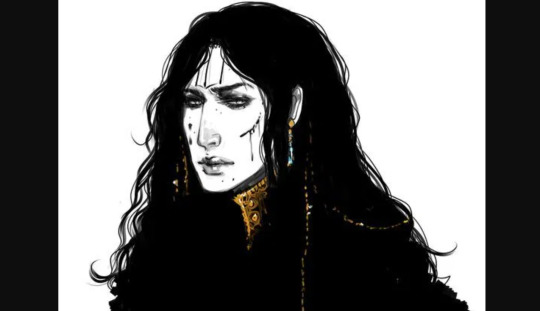
(Early fanart by @warickaart)
The most frequently drawn character, Malachiasz, has long hair, claws, and distinctive face tattoos. WS has a strong aesthetic in general, but those features clearly marked his fanart as him in a way even someone unfamiliar with the book could clearly track across different styles. Different interpretations of his tattoos from different artists even became a point of interest.
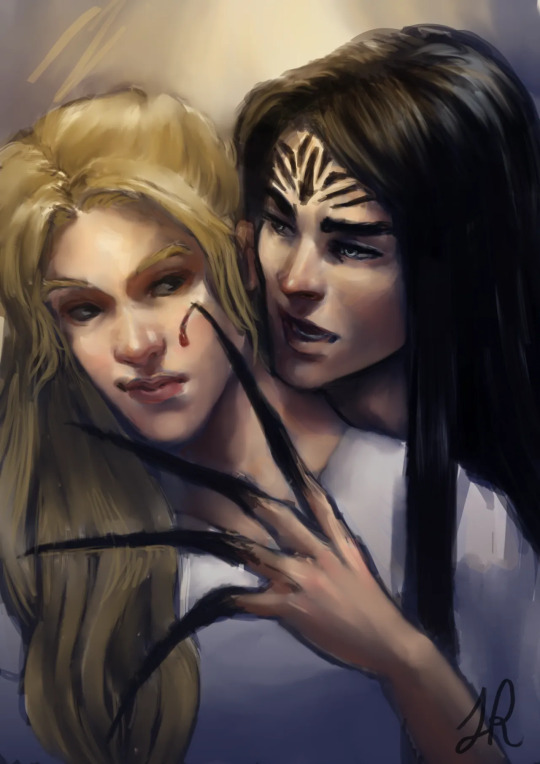
(Art by Jaria Rambaran, also super early days of WS Being A Thing)
Aside from distinctiveness, it's a clear visual representation of his history as a cult member, his monstrous powers, and the story’s dark, medieval tone. The above image is also a great example of character interaction, something missing from straightforward portraits, that communicates a dynamic. Character dynamics draw people into stories: enemies-to-lovers, friends-to-lovers, childhood rivals, platonic life partners, love triangles, devoted siblings, exes who still carry the flame-- there’s a reason we codify these into tropes, and integrate that language and shared knowledge into our marketing. For another example in that vein, I really love this art by @MabyMin, commissioned by Gina Chen:

The wrist grip! The fancy outfits! These are two nobles who hate each other and want to bone and I am sold.
In terms of true portraits, the best recent example I can think of is the set @NicoleDeal did for Roshani Chokshi’s GILDED WOLVES (I believe as a preorder incentive of some kind?):


They showcase settings, props, and poses that all communicate the characters’ interests, skills, and personality, as well as the glamorous, elaborate aesthetic of the overall story. Even elements in the gold borders change, alluding to other plot points and symbology.

For painterly accuracy in character portraits on covers, I love SPIN THE DAWN. The heroine looks like a beautiful badass, yes, but the thoughtful, detailed rendering of every element, soft textures, and dynamic, fluid composition form a really cohesive, stunning illustration that presents an intriguing collection of story elements.
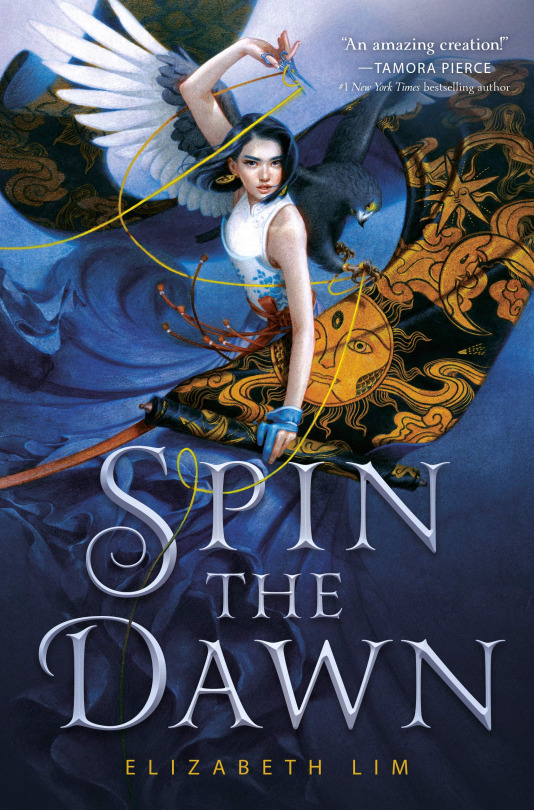
The devil isn’t always in the details, though: stark, moody, highly stylized or graphic art with an emphasis on textural contrast and bold color and shape rather than representational accuracy can communicate a lot (emotionally and tonally) while pretty much foregoing realism.
The new Lunar Chronicles covers are actually the best examples I found of this (Trying to stay within the realm of existing bookish art rather than branch into All Art Of Human Figures Forever):
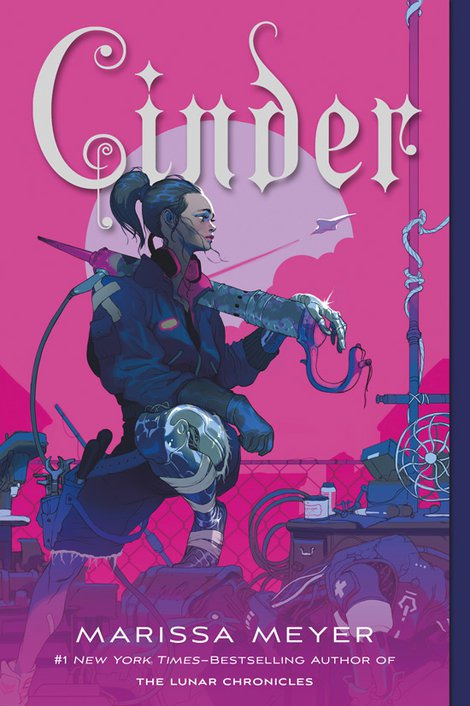
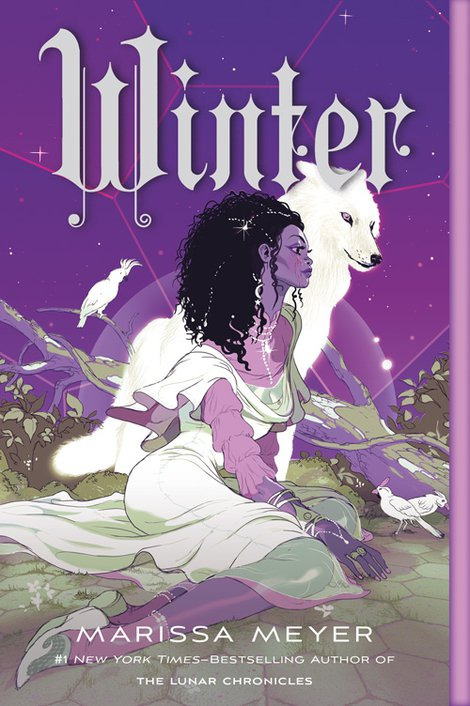
Taking cues from styles more typical of the comics and video game industries. (Games and comics, as visual mediums, are sources of incredible character art and I highly recommend following artists in those industries if you want to See More Cool Art On Your Timeline.)
TL;DR: Character art and design, as a marketing tool (even an incidental one) should be as unique to your story and your characters as possible, and tell us about the story in ways that make us want to read it. I tried to give examples because there are so many ways to do this, and so many different kinds of art, and I could give many more! But I’m bored now. So to circle all the way back:

These are not just bad because they look like each other, although that is embarrassing and illuminating. These are bad covers (although,,,,, PRINCESS is the far worse offender, at least FIRELIGHT suggests a thoughtful cultural analogue) because a desire for Pretty Character Art overrode the basic cover function to tell us about the story. We get no sense of who these people are, what their relationships are, what these books are about beyond the most general genre, or why we might care. The expressions are vague, the characters generic-looking, the compositions uninteresting and the colors failing to be indicative of anything in particular.
They’re somebody else’s baby pictures.
(And yes, that’s the CRUEL PRINCE font on PRINCESS. I better not have to do a roundup post but it’s on thin fucking ice.)
325 notes
·
View notes
Text
So while I was working on my… analysis I suppose, on why Digimon Adventure: does not work as a show, it occurred to me that despite claims that Taichi in Adventure: is inspired by V-Tamer Taichi, his partner is an Agumon whose final evolution is Omegamon, and why that doesn’t work. But I realized that it is a point that I could expand on, and so I have separated it out here. Consider it a preview.
The protagonists of Digimon V-Tamer are Yagami Taichi and his partner Zero, a Veedramon. The story is carried by these two alone. While others help and hinder them on their way, their mission is theirs, and the responsibility of defeating Daemon belongs to no one else. It is with that power that they reach their highest form, UlforceVeedramon Future Mode While Taichi is the main protagonist, Zero is just as much a protagonist. Their names, even reference binary. While there are other characters who impact the plot, the role of protagonist belongs to these two.
This is echoed in the themes of Digimon Adventure:, the digivice in the title supposedly representing the bonds between human and digimon. And, while I don’t think it particularly succeeds, I can see clear attempts to be made to make the digimon partners their own characters, equals to their human partners.
But yet, Digimon Adventure: uses Omegamon as Taichi and Agumon’s final evolution. And that is a bit of a problem. Digimon Partners are not interchangeable. Well, okay, the species are a bit arbitrary, all things considered, (after all, Zero’s rookie form is also Agumon) but the problem is what UlforceVeedramon represents vs. Omegamon.
In Digimon Adventure, Omegamon is not Taichi’s power alone. Not by a long shot. Taichi is not the solo human protagonist of Digimon Adventure. Even in the first film, before Hikari was even meant to play a key role in the series, she shared the series debut. Regardless, the burden of defeating Apocalymon is not his alone to bear. And Agumon’s evolutions reflect that. WarGreymon is reached through borrowing Hikari’s power. Omegamon is literally formed by WarGreymon and MetalGarurumon (who was formed by borrowing Takeru’s power), but in reality is born from the power of hundreds of people reaching out from across the world. And perhaps even Taichi’s crest of Courage is not something that belongs to him alone. As Yamato puts it, “It’s everyone's Friendship”. Though Taichi best embodies courage, the courage he wields is not his alone. Even tri. which I usually avoid using as an example, has Omegamon Merciful Mode, which very explicitly draws from the other children’s partners. Adventure’s Taichi’s not strong because he himself is powerful. Really compared to Hikari he seems rather unimpressive on his own. He’s strong because he is able to easily act as a receiver to others powers, a trait that is fitting for a leader. Because that’s what sets Adventure Taichi apart from his peers, he’s a leader.
Note, that I didn’t really bring up the partners in regards to the discussion of Adventure, not that they aren’t important, but that they aren’t a driving factor. Digimon partners are something vastly different in Digimon Adventure. They are reflections of the children’s inner selves. For straightforward characters, like Taichi, his partner Agumon is very much like him, and for characters like Sora, Piyomon seems very different. This isn’t to say that the digimon are simply their partners, Tailmon went through quite a bit on her own. But nevertheless, Tailmon is the way she is, because Hikari is the way she is.
Digimon Partners and their evolutions are not things that are just assigned, and given. They are things that arise from the circumstances. Omegamon is there because the themes and circumstances make Omegamon the most appropriate "Ultra”. This is true both in and out of universe, who can forget SkullGreymon? SkullGreymon isn’t wrong. It’s just not the evolution that fits Taichi and Agumon’s situation.
And here’s the thing. Digimon has done the whole focus on “Bonds with Partner’s” before. That’s Tamers. And in Tamers, the final evolution was born from a human and a digimon literally coming together as one. The final episodes all appear somewhat humanoid as a result, particularly notable from WarGrowmon to Gallentmon. Because that was what evolutions were needed narratively and thematically. Otherwise, we have Megidramon. And guess what, the Adventure timeline also has a movie in which the focus is on the bonds between human and friendship, and lo and behold. In Digimon Adventure Kizuna, Agumon (Bond of Courage) and Gabumon (Bond of Friendship) were born. Born from the bond between human and digimon. They even use the “looking like humans” idea from Tamers.
Interestingly, Kizuna came right before Digimon Adventure: started.
Now, I am really advocating for the Bond forms to be used in Adventure:, those forms were something special to that timeline. But that’s just the thing. Many evolutions, whether unique digimon or not, are brought about by circumstances unique to that timeline. Look at 02’s usage of Armor levels, Frontier's Hybrids, and Xros Wars' Xros mechanic. It’s not new for later seasons to take these Digimon that have existed in these specific circumstances and use them generically later. It would, after all, be a shame to put all those good designs to waste. But at the very least, the evolutions of the main cast are carefully chosen, created if need be, to fit the show.
And that creates a problem for Adventure: as a reboot. It is pulling from the evolutionary lines of its predecessor, despite aiming for different themes and using an entirely different world and characters, and in the process the meaning behind the evolutions has been stripped out. While it has been able to throw in additional evolutions, most of those are well within the confines of precedent: Armors and Ultimate’s that are already related to these evolutionary lines. Adventure: is trying to be a show that, as a reboot of Adventure, it cannot be. Adventure: spends so much of its time screaming that it is not the original Adventure, while simultaneously dragging in call backs that it loses any sense of identity.
The enemies they fight are not Taichi’s responsibility alone. These kids have to have crests. Agumon must evolve into Omegamon. Angemon still has to die, HolyAngemon and Angemon have to mean something. Tailmon has to be Adult, and has to have been evil. Hikari and Takeru have to give their brother’s power. Omegamon still has to appear. . They still go to summer camp, and Taichi still fights Parrotmon.
Note, that this is far from Adventure:’s only problem, however I do think it illustrates a large problem that affects the way certain elements and characters are used in this show. Taichi is a solo protagonist, but his “Ultra” is still Omegamon born of Yamato, Takeru and HIkari’s influence. Mimi is now a bossy rich girl, but her crest is still Purity. Yamato is a loner who doesn’t overly concern himself with others, but he’s still Friendship, and still Takeru’s semi-estranged younger brother.
When Adventure: manages to work a new angle into the old mold, it works well. Yamato’s focus on his friendship with Gabumon works well, and various side characters work alright. Resolving the conflict over Tailmon’s Ultimates by using both for separate things and bringing in Goddramon is a great idea. But more often than not, it doesn’t. Properly contextualizing what a holy digimon is is great, but Angemon’s death is awkward, and Pegususmon’s presence smooths over the issues of Tailmon being champion and keeping Angemon special in an awkward way, refusing to address what an Armor is. Because they are trying to write a story around a set of evolutions they are required to have while absolutely refusing to be Adventure where it matters. Leading to the awkward mesh of Adventure elements and characters, with themes and stories that they were never meant for.
If Adventure: was meant to be about the bond between Taichi and Agumon, Omegamon was never going to work, including the concepts of crests, was going to muddle things at the very least, and including 7 whole other partner pairs who are going to require at least a few episodes of focus a piece was not going to work out. It’s not that we couldn’t have had more focus on Taichi and Agumon within a reboot and their bond, or that the idea of Taichi and Agumon (or any other pair), activating an evolution because they are in agreement on a concept isn’t a good idea. Just an understanding that this primary focus wasn’t going to work because Adventure in its very concept has a lot of characters that need some degree of focus. Savers with its heavier Masaru focus and use of shonen tropes, dials back the number of “main” characters to half that of Adventure, because it is built around its premise. That unless they were going to be bumped down to secondary, recurring characters, this was never going to work, because that’s not how Adventure’s concept was intended. To tell a new story, it needed to have dropped a few more of Adventure’s elements. But to do that would be to essentially admit that this isn’t Adventure at all. Adventure: needed to have evaluated what story it could tell with what elements it was required to include.
Anything goes in Digimon, and Adventure: seems to want to make the most of this, using armors, Hybrids and Xros Wars digimon with regularity. But you can’t build a cohesive narrative simply by plucking your favorite ingredients and sticking it in a pot. Some things just don’t go together. You can’t take the ingredients to make bread and make a salad. But in short, V-Tamer Taichi and Adventure Taichi aren’t interchangeable. They are two different characters because they are designed for two different stories, and their partners reflect this. Adventure: was doomed from the start if it didn’t realize this.
10 notes
·
View notes
Note
oh dandelion is such a weird case tbh. like all the sleazy shit he does is entirely unnecessary imo but people have latched onto the womanizing and all as such a huge important part of is character that no one seems to really question it? and in part due to mistranslations its treated by fans as a whole as way less harmful than it is? idk but honestly its part of why i just think hes gay now bc his canon sexuality is a mess nd basically every non-platonic interaction he has with a woman is gross
(this is part 2 ig? sorry shdjs) for example idk how it looks in the translations but in the original like. one of the very first things dandelion talks about is how he groped one of nenneke's students, and the bit with the brothel in eternal flame is. really awful when you look at it esp with the (horribly constructed but still) race dynamics in-universe, when he talks about "being able to afford a half-elf or maybe even a full-blooded elf" like idk its just. Bad and i think ppl gloss over it
(okay i started writing this part of the response before i got part 2): yes, it seems to me like a lot of him is based on this trope of the slovenly womanizer bastard-sort, but sapkowski does nothing to invert that part of the trope, lol. he disproved being a coward, because he was brave to follow geralt into brokilon/stand up for geralt’s life in dol blathanna/etc. he disproved being an idiot, because he makes intelligent observations sometimes. he disproves being selfish, because he is very caring for geralt and others. but he does nothing to disprove womanizing/misogyny, perhaps except for how he treats essi as his little sister, and for how he is appropriate with shani and also good to ciri. also i suppose in something ends, something begins he has female friends who he does not act disgusting to.
(this is considering part 2 as well): YES. there are so many little stupid fucking moments that drive me insane. such as that one, i already mentioned the rape joke to yennefer in limits of the possible/bounds of reason, the comment he made about she-elves in eternal flame was disgusting, all of his stupidity when he first met milva (commenting on her body, and also making a comment about how zerikkanian women cut off one of their breasts to shoot better, even though this is refuted by milva). how he says in lady of the lake that women don’t need money, since they don’t drink or gamble (in the presence of milva, who has drunken in his presence, and angouleme, for whom gambling is part of her backstory). also commenting on how he finds philippa scary and that he categorizes women into “fuckable” and “nonfuckable” basically. i think his comments towards yennefer in a little sacrifice are maybe the least horrible (just saying that she is old and isn’t a ‘normal woman’ because she is artifically young due to being a sorceress) but is still annoying.
i feel like the concept of brothel-going in general is supposedly “of the setting/time” and is normalized in their society but is taboo and mildly alarming to at least some in a modern audience,
i think it is also partially due to sapkowski normalizing the brothel-culture in-universe, and also (on the translators ends, too?) to be keen i guess to use terms like “whore”, like i think he calls toruviel in edge of the world something like “stupid whore,” which, if it came out of a man’s mouth today, hopefully he would be strangled.
the thing that is annoying is that he is a “good character,” he is literally the best friend of the main character, and is meant to represent that best-friend role. so his actions and sayings aren’t intended to villify him, but to be amusing, so it is assumed that the audience would find all of this amusing, which it’s not.
i think he can have this part of his personality (not misogyny, lol, but the “womanizing” as it relates to “being a dumbass”) without being so horrible, for example when vespula kicks him out of the house in eternal flame, i find this funny because he is obviously in the wrong, and he is experiencing punishment for it. additionally, things like repeating urban legends that zerrikanian women cut off their right breast in order to shoot better, to which milva ridicules him. or when he in his ballad sung that yennefer had a heart like a diamond that was unfeeling, and yennefer addresses this with him, and he shuts up and tries to steer the conversation elsewhere because it is obvious that he is terrified of her wrath... it demonstrates that he is foolish and stupid, and is in the wrong, and can be made fun of. he did or said something (largely inconsequential, not violent or horrific) which was stupid, and is being ridiculed for it both in- and -out- of universe.
when he is in a position of power over the women however, saying derogatory things that men reading might agree with, that aren’t ever contested in-universe, then we have a problem. saying things like referring to women as whores, or trying to get a ‘full blooded she-elf’ at a brothel, or saying that he divides women into the fuckable and non-fuckable: these are never contested, he is never shamed for them, no one ever recieve retribution for them, and additionally, they are of a more violent and disgusting nature.
i feel like i treat geralt, yennefer, and dandelion all the same way overall. they each do and say some pretty messed-up things (geralt has sex with two barely 18-year old girls, yennefer smugly threatens to basically sexually assault geralt and was intending to mind-control a man into sex at belletyn (magic equivalent of a roofie; rape; what triss did to geralt), and dandelion espouses all of the misogynistic bullshit above). i like their characters but i simply cut this stuff out when i think about them because it adds nothing to them, only discomfort and disgust. it’s not intended to show “grey morality,” rather personal fallibility, and they are already fallible outside of such grossness. whether this affects if i headcanon dandelion as gay or bi i don’t know; i feel like it would be nice to rewrite some of his relationships with women to be more equal and less shitty (like how anna henrietta had an abusive husband beforehand and dandelion is not a violent man so ig it is nice to think she had some emotional love life with him around), but i also totally understand your perspective of just “there’s a lot to unpack here, but let’s just throw away the whole suitcase” haha. either way i think his [romantic] relationships with women are not very interesting at all, and i would rather focus on his platonic friendships with women, like milva, and/or mentorship/siblingship with essi.
11 notes
·
View notes
Text
Gochiusa BLOOM episode 2 impressions

The second episode of Gochuumon wa Usagi desu ka? BLOOM is now out, so let’s have a deeper look at some of the content presented in it.
In this episode: learn more about Japanese ghost tropes than you ever wanted to know, and the answer to the perennial question of nature vs nurture.
As usual, I spent a lot of time writing this, so any feedback is welcome.
The episode opens with a scene from Phantom Thief Lapin, an animated TV series for children which exists within Is the order a rabbit? universe (the technical term is “play within a play”, or 劇中劇 in Japanese). I’ve seen some people being confused whether it’s live-action or animated, since it’s not outright stated in the show, but in the manga it is referred to as “anime”. The show is inspired by existing properties featuring mysterious thief protagonist like Magic Kaito and Lupin III.
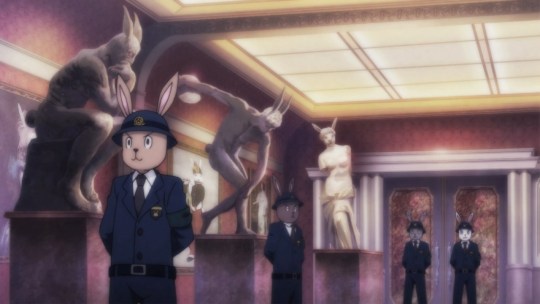
In the establishing shots of the museum we see bunnified versions of sculptures and artworks like The Thinker, Discobolus, Venus de Milo and Mona Lisa.
Soon, the titular Phantom Thief Lapin appears, and if you listen to the background music, you might recognize it as an instrumental version of the song which was originally released as part of Comiket-exclusive Phantom Thief Lapin set (here’s an old post with some photos of it).

As we see Cocoa and Chino reacting to the episode, the show’s credits can be seen in the background. Unsurprisingly it appears to have the same staff as Gochiusa itself. I was wondering if Aoyama Blue Mountain shows up in the credits as the original author, but she does not, however this fact is mentioned later.
After this “cold open”, we move on to the A part, which is based on chapter 2 of volume 5. We see Chiya trying to convince Sharo to participate in various scary activities with her, with Sharo having none of it. While horror movies are self-explanatory, the other two things are rather Japan-specific.
Hyakumonogatari (百物語) - a ghost story game, where 100 lanterns are lit up, and as each new story is told, a lantern is extinguished. It is said that a real ghost will appear if 100 stories are told, so the participants customarily stop at 99.
Kimodameshi (肝試し) - a test of courage where a scary location is explored. Literally translated as “trial of liver”, liver being associated with bravery for some reason.
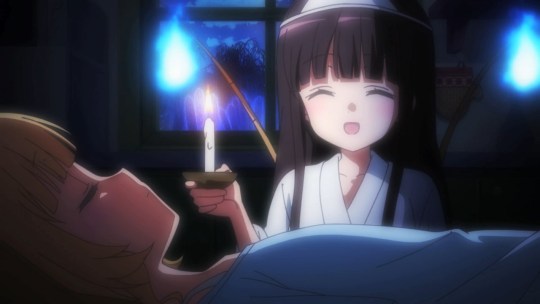
You might also notice Chiya being dressed up as a ghost. Japanese ghosts have some specific concepts associated with them, which are well illustrated in this scene.
Shinishozoku (死装束) - a white sheet that a corpse is wrapped in before being buried.
Sankakuzukin (三角頭巾) - “triangle head cloth”, part of the burial costume. Also called 天冠 (tenkan, “heaven crown”). Triangle pointing upwards symbolizes ascent to heaven.
Urameshiya (うらめしや) - a phrase often said by a ghost. Indicates grudge (urami) towards the living. While a ghost holds this grudge, it cannot ascend, and must stalk this world.
Onibi (鬼火) - “demon fire”, a phenomenon (similar to will-o’-the-wisp) of floating blue lights, which are said to represent the souls of the dead. It is never explained how the flames behind Chiya are actually produced.
Soon Maya and Megu are introduced, as “Team Beans”. The name comes from the fact that “mame” means “bean” in Japanese. This nickname was previously used in the name of the group “Petit Rabbit’s with beans”. We also see Cocoa planning something, which is kind of a spoiler for the rest of the story.

Some facts are revealed about Maya and Megu, namely that they’re childhood friends, and the fact that Megu is almost as tall as a giraffe. The official height for Maya and Megu was stated to be 140 and 145 cm respectively, but they seem to be slightly taller here, which might be explained by them growing up?
Rize tries to hit Chiya with water gun but misses every time. This is a reference to season 1 episode 4 where Chiya was able to dodge any ball thrown at her. This supernatural ability is never explained.
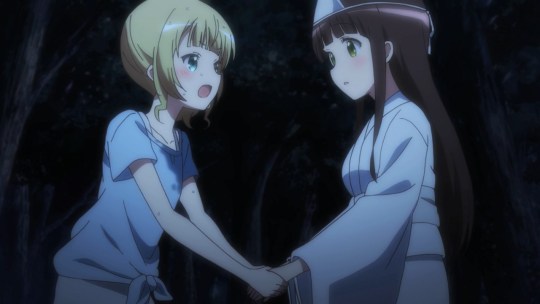
Sharo explains to Chiya how she’s grown since the old days and will be the one pulling Chiya forward now. This is related to how Chiya called Sharo a coward in the beginning, which she apparently took to heart. Funnily enough, Sharo still gets scared by a bunch of toy rabbits (and Tippy).
Anyway, it’s revealed that Cocoa was the mastermind behind it all.

And she did is specifically to bring Chiya and Sharo together, which was a great success apparently. “Suspension bridge effect”, anyone?
After this there’s an anime-original bath scene with Cocoa joining Sharo and Chiya in Ama Usa An. Interestingly Cocoa and Sharo used this bath before, in episode 10 of season 1, but not Chiya. Both scenes also touch on Sharo and Chiya’s past, with Cocoa acting as an outside observer. This type of wooden bath called hinokiburo (檜風呂) is considered quite luxurious and can be encountered in upscale ryokans.
We move onto B part, which is an adaptation of chapter 6 of volume 5. Cocoa is good at imitating Phantom Thief Lapin, and we learn that Aoyama Blue Mountain is really the original author of Lapin, which might explain why Lapin looks so much like Sharo. Interestingly in the manga it is mentioned how Sharo actually morally opposed to theft (both in this chapter, and the chapter the first half of the episode is based on), but it was cut in anime.

notsureifintentional.jpg but both parts begin with somebody peeking through the window.
Sharo is apparently really bad at impersonating Lapin, to the point where Inspector is a more popular character among children. However in Sharo’s defense there are plenty of works where the main character is not the most popular character... including Gochiusa itself.
Meanwhile, Cocoa appears to be a natural at this role, and eventually gives a piece of advice to Sharo: it’s not enough to wear Lapin’s costume, you have to become Lapin. Sharo doesn’t own a TV, so she didn’t see much of the show. There’s also another element at play here, namely Sharo always having to pretend to be someone she isn’t in order to fit in at school, and then having to fake smile for customers at her cafe. There’s a running theme of Cocoa not taking Sharo’s words for granted in this episode, which might be related to that. The idea is that children, and very pure-hearted Cocoa, have natural mistrust of Sharo.

The girls gather together to watch the show, and we see a bit more of the Phantom Thief Lapin show (as well as an unnamed “hardcore” show about a gun-toting samurai). It is revealed that the inspector has tragic backstory, which moves Sharo and Rize to tears. Also if you weren’t sure up to now, Sharo’s vow to protect her wife and children confirms that she’s definitely very gay.
In the end Sharo figures out how to do Lapin’s poses exactly like in the show, and thanks Cocoa by giving her Lapin’s mask. Which reminds me, why is it called a mask if it barely conceals anything about the person? Is this some sort of Superman/Clark Kent situation?
Next this episode features, for the first time this season, the ending sequence. It has a bunch of Alice in Wonderland references such as Tippy being the White Rabbit, and Chimame’s outfits. It metaphorically retells the backstory of Chimame (seen in season 2 episode 12) and how Megu and Maya brought Chino out of her shell. At the end the latte art seems like it will be different every episode.
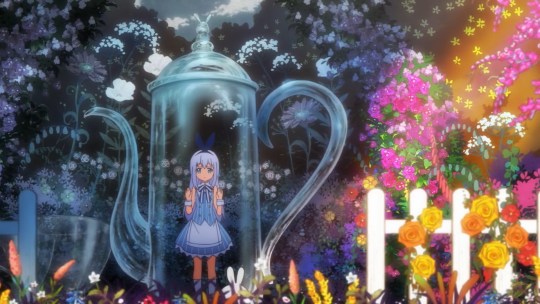
After the ED, we see Sharo showing off her new skills at Fleur du Lapin. Aoyama and her editor Rin can be seen in the background. By the way, what are the chances she named Phantom Thief Lapin after Fleur du Lapin, she seems like a regular there. Anyway, Cocoa comes up seemingly to support Sharo, but ends up stealing the show, guess you can practice all you want, but natural talent wins out at the end of the day.
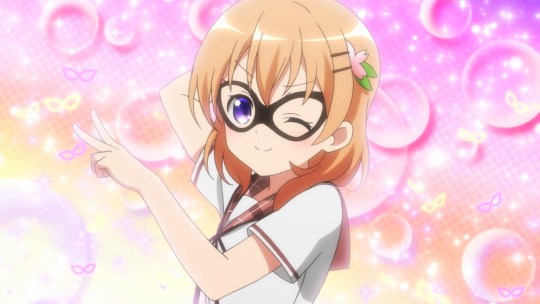
So that was the second episode, hope you enjoyed the review. Next up it seems we have Maya and Megu going to an open doors’ day at Rize’s school? Let’s see if I can write faster next time...
15 notes
·
View notes
Text
How To Analyze a Character
Have you ever been reading a fic and found the character is not recognizable that causes you to say “I don’t know who that is in that Marinette suit but that’s not Marinette.”
Or when you’re writing there’s that one character you need and you just can’t get inside their head to save your life.
This essay is going to delve into how to analyze characters and how they work in stories. It will help you both articulate why you do or don’t like a particular character or their interpretation, and help you in your own writing of that character.
Characters, as well as other elements of a narrative, can be broken down into collections of recognizable elements often called “tropes.” (For the comprehensive taxonomy see tvtropes.org.) These commonly recurring literary and rhetorical devices, motifs or clichés can be combined in unique ways. They exist as recognizable and namable concepts because the same patterns are used over and over again in the creation of stories. We can use named tropes to describe what we are seeing in one story and relate it to other instances of the same phenomenon.
The advantage of recognizing the tropes that describe a character means that we can import into our understanding of them all of the other instances of that trope we have come across, and then compare and contrast these characters.
For example, both Chloé and Adrien exhibit the “Well Done, Daughter/Son!” Girl/Guy trope, desperately seeking the approval of a distant and withholding parent. (Faramir in the Lord of The Rings and Shinji Ikari in Neon Genesis Evangelion are also prime examples.) Knowing that they are both participants in this kind of relationship we can see how it plays out differently.
Gabriel seems like a deliberate ass, but occasionally manifests approval as when he played the duet with Adrien before sending him off to the Kitty Section concert in Capitan Hardrock. Audrey is entirely un-reflexive in her horribleness, dismissive rather than demanding and only ever recognizes Chloé’s worst feature as admirable. Kagami is also a “well done daughter!” girl and it informs how she relates to Adrein, Chloé, Marinette and Ladybug, providing both for character connection and thematic contrast.
On the production side, tropes can be used deliberately to construct a character to achieve a particular purpose. Adrien was created using the standard tropes of the fairy tale princesses beauty, musical talent, kindness to all creatures (even Chloe), kept looked up by an unloving parental figure. By creating a stereotypical Disney princess but swapping the gender it causes us to think harder about the assumptions we make about Princesses.
Symbols work the same way. We use symbolic images and language in media because it allows us to reference all the other ways and places that symbol is used. It becomes a shorthand for much bigger units of meaning. Pure originality would be completely unintelligible.
For example, Marinette displays two flower motifs on a regular basis. One is the cherry blossom spray across her shirt. Commonly this is associated with both love and passion, as well as purity and transitory beauty. In China, the last three are more closely associated with the Plum blossoms that decorate her purse, chair, and diary. Along with the additional significance of perseverance and hope, we can see that her dreams for the future, however heard she works for them, may not turn out as she plans.
The cherry blossom, in China, is a symbol of passion, strength, and feminine power and sexuality. As Marinette has this symbol peeking out from behind her jaket on the left side of her shirt, it represents how her civilian persona hasn’t fully come into the power she displays as Ladybug. Adrien’s kwami was chosen to be a Black Cat specifically to call up all our associations with them and bad luck as a counterpoint to Ladybug and her Lucky Charm.
Pikachu, I Choose You!: Artistic Decisions
You would think this wouldn’t need to be said but remember, remember, remember: these fictional characters are not real people. Why does that matter? Because everything you see on the screen or on the page is the result of a choice made by the writer or artist.
Images and dialogue may be selected deliberately, thoughtfully, thematically, instinctually, carelessly, haphazardly, or stupidly, but they are there because the authors and illustrators and creators selected them to be there.
Remember that the characters only exist to serve the story and everything about them ideally should serve to move the story toward its conclusion.
This is especially pertinent in an animated–and especially a computer animated–show because everything has to be made specifically for the show and they are expensive to make(MLB costs ~$460,000 an episode). That’s why you get only one outfit for most of the characters, except when absolutely necessary.
Saving their production budget for other things is why Theo Barbot has all of the odd jobs in Paris, there seems to be only one cop, Sabrina’s dad, and Alec and Nadja are the only people on TV. If you take a look in Bubbler, the first episode aired in the US, you can see that the school, the bakery, the hotel, and the Agreste Manor are all within one block of each other.
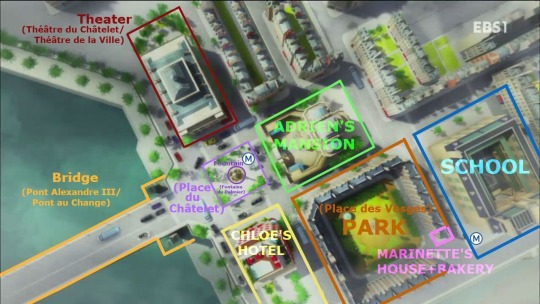
CallMeDale posted this to the Miraculous Fanworks Discord. Source unknown. Image originally from Bubbler.
What this production cost means for analyzing a character (or anything else) is that everything we see in a visual medium is important. Everything about a character has been picked for some reason. How they look, how they move–even how they stand says something about who they are as a person, who they are in their relationships, and who they are as an element of the story.
I did a fairly comprehensive essay on Chloé as a character so I want to walk through some of the things I looked at in order to write it.
Character at First Sight:
First impressions are vital. Because Marinette is picked to be our eyes as the OP starts (“In the daytime I’m Marinette,”) we know she is supposed to be our heroine and point of view. Everything that happens after that is to be judged in relation to her. The first time we see Chloé in the show is a whole 5 seconds into the opening, when she and Sabrina walk past a face-planted Marinette. Immediately afterwards, Chloé runs back in to glomp Adrien and push Marinette out of the way.
From these few brief seconds we know that she is both rich and domineering, Sabrina is walking just behind her with a huge designer purse and bookbag, obviously in a subservient role. Chloé laughs at Marinette, which establishes her as an antagonist to the Heroine. Chloé pushing Marinette out of fram when she comes back shows that she exists in part to block our Heroine from Adrien, our Hero, whose expression shows he really doesn’t appreciate the attention.
Not even three seconds of screen time and we already know who Chloé is in relation to three people: Marinette, Adrien, and Sabrina.
How much time a character gets in the beginning of a story also sets up how much brainspace we allocate them and our expectation of their importance. This is one reason I prefer Bubbler as the “first episode’’ (US viewing order) over Stormy Weather (South Korean/International Viewing order). Stormy Weather spends the first few minutes on Aurore, Mirielle, and Alex before getting to Mari, Tikki, Manon, Alya, and Adrien. Bubbler in the same first minute sets up Marinette, her parents, Adrien, Alya, Chloé, and Nino and all their relationships.
By choosing your descriptions carefully you can get the reader to think of other things without directly mentioning them. Ladybug’s costume, mode of travel and name all callback to Spiderman (she even does the upside down hang in Dark Cupid), and even though the iconic phrase “with great power comes great responsibility,” is never stated its influence is felt in the persistent characterization of Ladybug as ‘all business’ in fic, even though she is more playful in canon. Master Fu is modeled after classic inscrutable mentor Mr. Miyagi from the original Karate Kid movies, it gives him an air of perhaps more wisdom and knowledge than he actually possesses.
Come on Let’s Vogue: How the Look of a Character Informs Us
Now let’s look at what we get from the elements selected for Chloe’s character design. Slender, pale, almost-white blonde hair, sunglasses on the top of her head, lots of blue eyeshadow, yellow jacket over a black and white striped shirt, white capris and black and white flats. All of this says she is the top of the social heap at her school. Combined with her glomping and trying to kiss Adrien and we can guess she is–or at least wants to be seen as–romantically “experienced”. Yellow is a happy color, it’s what makes a printed picture look bright. Often, though not always, it is associated with success and general goodness (i.e. a heart of gold) so she is initially portrayed as a person who doesn’t have any cares. White jeans and shoes point to both her status as someone who doesn’t have to work and a certain level of naivete.
But she also has this very gothy studded belt around her hips. It is very obviously not holding up her pants. This hints at the darker emotions and experiences at her core. The black and white stripes of her undershirt hint at the way she is held prisoner by her past.
Because we have been set up to see Chloé as the spoiled,rich bitch with everything she could want, when the facade cracks and we see just how awful her mother is it hits all the harder for us. Chloé’s invulnerable image is destroyed.
“What’s in a Name?”: Tagging as Character creation
Names are also a good starting place for getting into a character.
Bourgeois comes layered with the connotations of wealth, but not too much, and shallow conformity. Chloé is derived from the Greek Khlóe, or ‘young green shoot’ (of a plant), which can also be interpreted as meaning 'blooming.’ Khlóe is an epithet, or nickname, for Demeter in her aspect of the Lady of Summer. We know the writers know and are thinking of these meanings because of these lines in Sandboy.
Nightmare Adrien: Marinette, for your birthday, I’m going to buy you flowers—
…
Nightmare Adrien: —hortensias, roses and Chloés. (Marinette shrieks)
Not only does her name sound like that of a Homecoming Queen/Cheerleader/trust fund baby, but it also indicates she is immature but with potential to become something more.
Queen Bee is also laden with meaning as it is a term used to describe girls in their teens who are at the top of their social pecking order (see Queen Bees & WannaBes). It perfectly describes bothe how Chloé acts but also how she perceives herself.
The Things You Do to Me: Character Action
Characters in a story are what they do and more importantly why they do what they do. If Marinette becomes Ladybug for the first time because someone needs saving (first Ivan, then Alya), and Adrien becomes Chat Noir in order to escape the gilded cage that is his house, Chloé dons the Bee miraculous in a desperate (and unsuccessful) bid to catch her mother’s attention.
Attention seeking is part of every subsequent time that her hero persona appears in the story. Consider the implications of the fact that the signal on her roof is a Bee signal, not a Ladybug signal. The gestursal tic she has of always examining her nails, often with the other arm folded over her chest, is a visual shorthand for both her self-absorption and that her unpleasant personality is a defence mechanism.
Dialogue clues are also important, especially things that come up more than once. Chloé’s persistent lack of remembrance of the Concierge’s name (Jean-whatever) shows her to be dismissive of the people she believes to be “beneath her” which becomes horribly ironic when we find out her mother doesn’t seem to remember her name. That Marinette is always Dunain-Cheng, emphasizing her parents status as tradesman and that Marinette is not pure French operates as a persistent put down.
Chloé is a Hero with an F in Good, primed by the writers for the Face–Heel Turn which happens in Miracle Queen. They telegraph this event by the choice to echo her “once a monster always a monster,” line from Stoneheart, in the S3 midseason Stormy Weather 2. There she mocks Aurore with “once a villain always a villain.” Highly ironic given the number of times Chloé has been akumatized and prompted it in others. Her bad heroing serves to show that actions and motives are not always aligned and to highlight the selflessness of the other heroes.
A great example of showing character through dialogue is Nino’s conversation with Gabriel in Bubbler. Nino was given a very distinctive, persistent, and casual speech pattern (“dude” in English), It’s so distinctive that Alya immediately recognizes that he is Carapace. The fact that he makes an effort to suppress it when he is trying to persuade Gabriel to let Adrien have a birthday party shows how much he cares about giving Adrien this gift. It’s part of what establishes him in our minds as such a great friend for Adrien (King of Bros!). Giving characters individualized vocabularies and speech patterns is one of the best ways to help distinguish them in both your, and the reader’s mind.
All Together Now!
As you read and experience more stories, you will recognize more and more common elements across the characters, places, events and ideas that make up the stories you read. As you recognize these building blocks, and how they can be combined and manipulated, they will help you understand better why certain characters do what they do in the story. You can then deliberately select them as you create your own stories to highlight desired themes, set up conflicts or call cultural resonances to your readers’ minds. Remember what you write is a conversation between you, your reader, and the world around you. The more of the world you can bring into your writing the deeper it will impact your readers.
22 notes
·
View notes
Note
Do you think that in the Tadeo Jones universe, some people (average or rich people) think living mummies aren't persons but some creatures they can capture and claim as their own 'cuz they have no rights? (as mentioned by Tad in Movie 2) Kind of like the Apex's view of denizens in IT. I think this could be adressed in Tad 3. But I'll be sad because Mummy is going to find the hard way that for powerful people, his feelings and opinions doesn't matter (Twice, if we count the Spanish conquista)
Ohhhh man!
I have been-- stewing over how best to answer this since I saw it yesterday, because part of me has IDEAS-- the other part has a rant that has kind of been building for a while in general when you just examine the movies and the setting and even the actual community represented in reality(that being Archaeologists not-- well)
And LOOK-- I have TEA!
Frustrated, frustrated tea regarding other aspects of how this all could play out that basically boils down to the one major issue that a lot of those groups has is the issue of "But WE all know!" and the we've boxed this in already.
Which-- Debatably, Tad isn't the only one with some issues... But Sara has-- at least insofar as her reactions to Mummy in movie 2, come to terms past her more nebulous in concept repeated line.

"Mummies can't be alive, it's a contradiction in terms"
Which-- actually might be an issue that's just on the question of the life/death binary more than it is actually a question of whether someone is human/a person or not. And we ALL know she's definitely got Major Respect over Tad--
Like, I will write a proper analysis over their "Mummy gives advice/pep talk" scenes later-- but--
Sara doesn't just take it and run how Tadeo does-- and she doesn't get hyped about it either. It's soft and subtle and just ARGH--
--
Which, okay beside the point, but I have-- so much on this idea of how people view Mummy-- Because let's for a moment consider what Tad actually says-- in answer to Mummy's "What is with you?" and I want to also talk on what people tend to associate with and call monsters... and how... that might also factor into this whole mess.
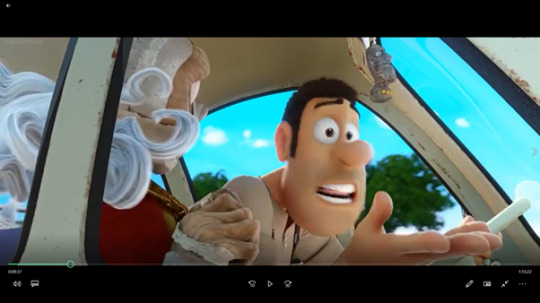
"Listen you're a mummy, you scare people. In my world you're a zombie!"
Which-- okay, on the surface this is just an on the nose point about how well, Mummy is undead. Ahahah, the living dead and I suppose living mummies are their own form of zombie-- although really it's more like they're cousins as zombies are usually more... in process of decay while mummies are preserved/petrified... Buuuut in any case... not the point here really.
But rather...
Let's talk about how "Monster Movies" come in here. And what zombies tend to be synonymous with nowadays. You know-- for the most part. Mindless, brainless, sometimes killers though not always-- But ultimately-- Does... anyone actually watch zombie shows for in-depth exploration of zombies ever anymore? Aside a few exceptions, and same in games-- Zombies are relegated to just brainless/mindless monsters.
Which--
On the other side of that-- monsters.
Tad never quite uses that word but--

"First, you're not human"
Mummies-- are monsters. In stories and fiction. Used to scare, used to awe, used to add scenery dressing, spooky, freaky, creepy-- and when they're not-- well it's rare. But if they're not the villains, they're not "human". Which think about that for a moment, in all the monster stories we have but a few where the monsters aren't outright put in that position.
But a monster is usually in a story put into one role and box. And if they're not outright there just to be spooky, or the whole new misunderstood monster trope-- which well, that's a whole other thing. But we all know the usual "monster shtick".
Violent, scary, simple, dumb, driven by base impulses, nonhuman, Very, very often as lesser, other, and something to be feared/hunted/destroyed.
And while modern day does move away from that--
ISSUES still prevail.
And I have-- just got to aside here, but like, thinking on this but-- the Phone Mummy sign outside of Tad's window as a child has some... other weird things. Because as a wild aside, my dumb brain has decided to A - B link this with a series I watched on television from 2005-2007

Because of THIS stupid Mummy Scam Artist character. And it's dumb, has nothing to do with the issue of mummies(and other potential beings and creatures of myth and legend) having less rights. But this whole phone billboard-- with the Mummy, it's legit right up this character's kind of scam alley and I may or may not one day just rewatch his two villain episodes to get his personality clear in my head JUST to do a dumb crossover.(And for nostalgia, but that's not news)
BUT--
Advertising does tell us some things already. In how people possibly think and could respond/react.
Yet still-- there is something more I think that we're missing in this conversation on how people will potentially treat the discovery of a living mummy. Or really any supernatural being. If not with fear(which look-- fear the unknown, fear different, fear of monsters), arguably those who're intrigued, interested could be far, far worse.
Also-- I just have, much tea on other responses for even those who might briefly "respect" him. Because look-- Mummy would be a priceless artefact in a way, treasure and discovery all on his own-- BUT also a new potential source of information of a culture that for the most part has been lost and erased by history.
People could and would ask questions.
Whiiich is where I have doubts about how they will accept the answers to those questions. Because here's the thing, for all the Archaeology community loves to act as if they let discoveries speak for themselves, and even I suppose historians-- There are just-- so many times I watch and listen to documentaries and get SO FRUSTRATED-- because they're stubborn IDIOTS, who actually refuse to take in the evidence in front of them of any truths outside of what they're SO SURE has to be the TRUTH!
For those who speak of learning all about history and it's secrets, they're so damn high and mighty to reject anything that doesn't immediately fit with already established "facts". It must be an anomaly, aliens, can't be what we're actually seeing right--
And well even people today interacting-- Like-- I've seen people try to correct someone on the pronunciation of their own name before.
So I am almost certain there would be at least one idiot who'd be all high and mighty and just-- Mummy has LIVED it. It's his culture he grew up in and some idiot speaking over him saying his lying, which I just-- I am certain would happen(but probably not in canon because who would DARE?!)-- Just "EXCUSE ME?!"
Which is it's own kind of disrespect and hell, crash Tad's pillars again. Yes please!
Which... on that account--

I kiiiind of want to talk about how Tad needs a smack on this... and that wake up to the truths of the high and mighty and bloody prideful issues of the community. BUT more than that-- I actually want to think about that point you made about how Mummy's supposed transformation in movie 3 comes across and the further themes of this question of humanity and rights is in regards to this whole issue.
Because yeah, there's the issue, front and CENTER.

The question/implication of this resembling Ammut, and implied loss of humanity. Along with the fact that Tad's the likely TRUE CENTER of the curse-- since he's the idiot who opened the sarcophagus in the first place...
WHICH CAN I JUST SAY--
There's a very good possibility in regards to that issue-- potentially having to do with some of Tad's more... subtle issues. Or even the ones that are close to the surface and yet not. I've screamed already on Tadeo's Internalized Ableism... along with some small nods to Mummy's own less severe cast with that but-- This is directly playing into that image of monsters and nonhumanity--
And I could probably add an additional few pages of speculation onto this but--
I actually am... also worried for the pets. If only because uhhh, have you seen the original two Tadeo Jones shorts from before it become movies? https://www.youtube.com/watch?v=2XxhNMbpE2A & https://www.youtube.com/watch?v=uoJBzI2AUOw
I mean not assuming anything, but I can definitely believe they wouldn't be above having that threat present at the least.(I mean just that second one... with what I guess is concept-Jeff) Even if Mummy is most definitely going to be the one at the MOST RISK. But with that-- comes the question of humanity.
And while yeah-- I do imagine, all too easily there will be many people more focused on the discovery-- I think there's an interesting mess that Tadeo is going to be FORCED to confront with this-- in how he has that displaced view.
Because here's the weird thing.
I've kind of mentioned it before but not really expanded or explained very clearly-- but for all of Tad's issues... he cares about Mummy probably more than he even really realizes. It's in small to big things as well. Again-- for all his trash behaviour in movie 2, I do think a lot of it is very, very misplaced attempts at some form of protection...
Which I also really want to at some point make a post that's just...
"Tad's I'm Helping moments and how they made things worse for everyone"
But that's for later... For now...
I kind of want to grab a few things.

"You're already dead, RUN!"

I also actually counted how quickly he ran back to Mummy for this moment, and it's LITERALLY two seconds, from when Mummy collapses to Tadeo's check on him. Also I'd like to mention with this-- he's supposedly tunnel visioning on Sara(and he ruins it within the next scene pretty quickly)
...
And for all they're kind of dumb decisions.


DEBATABLY-- when he's trying to hide Mummy.
"Hide"
Ugh-- BUT Tadeo has a very... complicated issue here really. Because yes-- Tad very much has that nonhuman issue, but he CARES. And then-- there's how the whole Ammut thing feels set and the symbolic meaning there(ALSO INTERESTING SARA SEEMINGLY ISN'T CAUGHT BY THAT). But here's the thing--
With Ammut kiiind of come those scales and the feather.
It's not like that mythology isn't unknown-- but more to the point-- it feels kind of like force Tad to confront his mixed up view. On Mummy's humanity or lack of-- But really as the audience Mummy feels the most human at this point in time-- whiiich we can get into a debate on what even is human nature later-- but--
I am kind of hoping that we get a callout of a number of things regarding Tad's behaviour.
With some primary focus on this dynamic between him and Mummy and really seeing how he responds to that idea that Mummy is nonhuman to really be thrown into full view and scope. And listen...
You cannot cheat the scales.
...
As an aside generally, if he is turning into a form or version of Ammut even if initially the community is a danger because he's a living mummy that creates a whole other issue of how he'd be viewed as a danger due to the role that's possibly growing more and more of an instinct.
But yeah... I will probably now make a more formulated rant on this later, or like, minor expansions on the topic but-- yeah.
I have been CHEWING on these thoughts, ideas and concepts for a while.
With additional tea. Because when people think they know something too often they refuse to see differently.
(Also at some point I am going to make a personal rant on duality verses binary due to insistent terminology issues I have but ugh)
#THybrid Responds#THybrid Jones#Tadeo Jones#Mummy(Tadeo Jones)#Sorry about making this a rant#But I literally mused ALL DAY#So you get 10 pages worth#although I still theoretically have more#because this is a nuanced concept#and I have a lot of feelings#but I don't want to get too deep into some of my theories with movie 3 yet#because plunnies#araminakilla20#Life and Times of Juniper Lee
11 notes
·
View notes
Text
Interview // Daughters of Reykjavik

For The Forty-Five. Read online.
Dry pussy feminist bitch?” Salka Valsdottir is trying to recall the most offensive comment her band has ever received online. “There are so many bad ones,” the rapper and producer smirks unruffled, speaking over Zoom from the Berlin studio in which she works. In the seven years since their formation, Daughters of Reykjavik – FKA Reykjavíkurdætur – have become depressingly accustomed to verbal abuse. It’s heartening, then, to hear them reclaiming these very slurs on new track ‘No Comment’, and not least because the song forms part of ‘Soft Spot’, their new record and the band’s strongest body of work to date.
Released in May, this self-produced second album represents a giant leap forward for the all-female hip-hop group, eclipsing 2018’s debut ‘Shrimpcocktail’, both in terms of ambition and execution. Now a tight, nine-piece outfit – rather than the nebulous, 20-something-strong collective that first found international notoriety at Iceland Airwaves festival in 2015 – their beats are sicker and bars are slicker, and despite clearly aiming at a larger audience they’re making no discernible concessions in regards to their famously frank subject matter. One moment they’re skewering their more materialistic instincts (‘Fool’s Gold’) or flipping misogynistic hip-hop tropes (the Eminem-bating ‘A Song To Kill Boys To’), and the next they’re exploring female solidarity via a sweet, Spice Girls-inspired bop called ‘DTR’.
We sat down for a lockdown video chat with Salka and band mate Steiney Skuladottir, and talked trolls, empowerment and achieving world domination, one baby at a time.
So it must be a bit of an anti-climax releasing an album during lockdown?
Salka: “(Exhales slowly) Yes. (Laughs) We did have a lot of great reactions and reviews online, so it did feed our egos a little bit, but not as much as it would usually. Which is probably a pretty good thing – sometimes you get a little bit crazy when you’re releasing something. What I think is sad is that we’re not going to have this momentum to tour with this album. But I don’t know, maybe it was better for this album anyway, because it’s a pretty soft album in many ways; an album that was intended to be streamed more than it was necessarily to be performed live. So now we’re going to have to make a huge party album and release it and tour with that.”
How has reducing your numbers to nine impacted the creative process?
Steiney: “This record was very different from the others because Salka said she wanted to produce the album – which we loved. Before, we’ve always had random beats from random producers, but Salka wanted to make an album that takes you on a journey, from the start to the end.”
Salka: “Also, writing was a way more integrated process than in previous projects, where we’ve written in pairs and then we’ve met and hustled the verses together. But this record we wrote mostly in the summer camp when we were all together, bouncing verses back and forth. And as a result I think it became way more fluent and integrated and personal, and that everyone was able to very much channel what they were really good at.
Steiney: “I think we could have a Ted Talk or something about how to work in a group. We’re so good at it.”
Salka: “All of us have to work in other jobs as well. So you have to be pretty dedicated to prioritise something that doesn’t pay your bills. And for the past two years this has been a very, very time consuming project. So some of the [former members] wanted to focus on something else, or had children and didn’t feel like doing both with their other work.”
Speaking of which, I was really impressed to see Sura performing while heavily pregnant in the video for ‘Thirsty Hoes’.
Salka: “Yeah! There’s always one pregnant person. Always. We’re nine and four of us have children. Including the members that are currently working in the band and the members that have been in the band, how many babies have there been born this year? Six?”
Steiney: “Yeah I think so.”
Salka: “There are, like, six new Daughters of Reykjavik in 2020”
Steiney: “We are naturally taking over the world by reproducing.”
You look back on your band history in the video for your latest single, ‘DTR’, right?
Steiney: “Yeah, It’s old videos from our phones from the past five years, when we started touring abroad.”
Salka: “We also decided to include every member that’s ever been in the band. It’s so crazy to see how many members have fluctuated through this little system.
Steiney: Basically, every single girl you will see on the screen has been in the band. I think it’s 23 people.”
The concept for the video fits so well with song, which is basically a love letter to each other. What prompted you to write it?
Steiney: “We’ve often had the question, ‘Who do you look to for inspiration, and who do you want to be like?’ And it kept coming up that we were like, ‘I think, just each other.’ I never feel as powerful as I do onstage with this group of girls. I feel like I can do anything – I can fuck up or I can do something amazing – and they’re always going to love me no matter what and celebrate whatever I do. It’s such a big difference from the rest of this male-dominated world. It’s such a relief.”
Salka: “The dynamic of the group makes you feel so powerful. When we were writing the record at the summer camp a year and a half ago, I think this was one of the last songs we wrote. We were reminiscing and thinking about how we could make something that would be for us, and to confirm the feelings we have for each other and for this group. I don’t think there are a lot of songs in Iceland that are specifically made for or about female friendship, and the confirmation and admiration women have for each other. I was just imagining 13 year old girls drinking for the first time and singing this song at karaoke, crying.”
Steiney: “‘You’re the one who always reminds me of the strength I have inside.’ That’s the chorus. And it’s just so on point of what this group does, I think, for every single one of us.”
And you’ve had to put on a united front because you’ve faced a lot of resistance back home. Do you think that criticism is essentially fuelled by misogyny?
Salka: A lot of it has been pure misogyny. And when you get really used to really, really sexist comments and someone tries to approach you with an opinion that is actually more like constructive criticism, I have caught myself just being too defensive to even be able to listen.
Steiney: Especially because at the beginning it wouldn’t matter what we would put out we would always get these hateful comments from the media here in Iceland. And we got famous very quickly in Iceland. Basically in one night.
Salka: Also, when we started we were amateurs. We were having fun and we were trying something out that we weren’t necessarily comfortable with or confident in. I think women especially get scrutinised for being amateur. It’s almost completely unacceptable. To have this group of this many women that all sucked but were still having all this fun, I think that inspired as many people as it infuriated. But there were a lot of shitty, blatantly sexist comments. It was a really crazy mirror on Icelandic society as well, which is recognised internationally for being progressive.
You’re scheduled to play Iceland Airwaves in November. What can we expect from the show?
Steiney: I think it’s gonna be such a good gig because we’re gonna be so fucking excited and eager. The only thing is I’m scared about is that somebody’s just going to injure themselves because we’re overexcited. That somebody’s gonna run off the stage…
Salka: That’ll be you, Steiney! You’re going to fucking do it (Laughs) But you can expect energy. A lot of it. Too much, some might say. Like, a lot of interactivity with the audience, a lot of chaotic choreography. Somebody once called us shitty Pussycat Dolls. (Laughs)
Steiney: That’s what you’re gonna get. (Laughs) With, I guess, more danger.
Salka: Pussy Riot meets Pussycat Dolls.
#the forty-five#interview#interviews#daughters of reykjavik#new music#music#soft spot#reykjavíkurdætur
1 note
·
View note
Text
95. buddy the dentist (1934)
release date: december 15th, 1934
series: looney tunes
director: ben hardaway
starring: jack carr (buddy), bernice hansen (cookie)

the last cartoon of 1934! i can’t say it was an exciting year—probably the least memorable year yet. the merrie melodies started to go into color, though, which is exciting! 1935 will be a big year. porky makes his debut, as does tex avery. termite terrace would be born, and the world has never known peace since! also interesting to note—jack king’s an animator?? i wonder how that happened. a little job on the side?but for now, we focus on buddy, who plays dentist after his dog suffers a toothache from eating too much fudge.
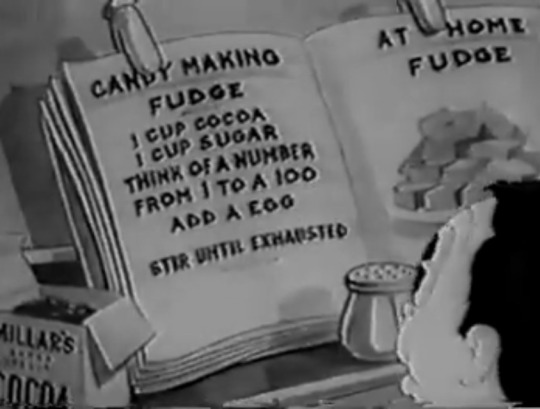
someone’s in the kitchen with buddy, someone’s in the kitchen i know. someone’s in the kitchen with buddy, it’s his pup, bozo. buddy’s whipping up a batch of fudge, with enthralling and rigorous instructions such as “think of a number from 1 to 100” and “stir until exhausted”.
bozo sniffs the fudge, to which buddy scolds “ah ah! burny burny!” i think that’s the LEAST of your concerns if your dog is that close to chocolate. nevertheless, buddy gives his dog one last knowing glance as he strolls off, the fudge unattended. bozo takes this as an opportunity to lick the boiling death trap, yelping in pain at the burn. very amusing to watch him sucking up water desperately to playfully lapping it once buddy comes back in, shrugging.
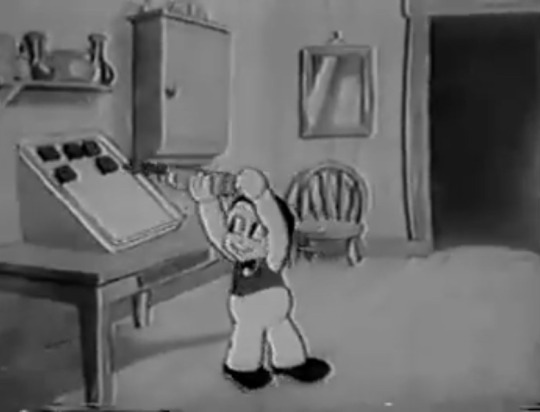
quite the masterful baker as buddy pours the contents of the pan into a syringe, flipping the pan back on the shelf and balancing the syringe on his finger. he shoots squares of fudge onto a cookie sheet, and one into bozo’s mouth to pacify him. i’m not gonna riddle the review with “HE FEED HIS DOG CHOCOLATE 😱😱😱😱”, but just know i found the entire concept hilarious as i watched it and all i could think of was “this is such a bad idea”. bozo instigates, wanting more, but buddy reprimands him, scolding “that’s all you get. and besides, candy’s bad for dogs’ teeth.” begrudgingly does bozo mock buddy once he leaves the picture. of course, buddy catches him sniffing the pan of fudge and orders him to come near him.

buddy rings up cookie while bozo sulks next to him. i love the detail of the bird listening in on the conversation. buddy teases cookie, promoting her to guess what he has for her. he entices her with a promise of some fudge, while bozo, seeing that buddy is effectively distracted, seeks out the pan of fudge. it topples to the ground, and his mission is accomplished as he eagerly indulges in a few hearty helpings.

all of the sudden, bozo yelps in pain as a bell chimes forebodingly. a visit to the mirror confirms he has a toothache, represented by a little figure (i can’t make out what it’s supposed to be: a dog, a flea, or satan are my guesses LOL) hammering away at his tooth. i wonder if this is a jack king scene? since he loves his open mouths so much. bozo cries in pain, which prompts buddy to break his goody two shoes persona and shout “hey, shut up! shut up!” ah, misunderstanding, another great comedy point. cookie believes buddy is telling HER to shut up and hangs up on him, scoffing that he can’t tell her to shut up. damn right!

aggravated, buddy runs into the kitchen (first time holding the ear piece and accidentally getting yanked back into the living room) to see what the fuss is about. he drags bozo by the collar and props him up on the table, exclaiming “now see what you’ve done!” bozo is too distracted by the pain to be properly guilt tripped, and buddy inspects the situation. instead of angry, he cracks a grin as he tells bozo “see, i told you candy would hurt your teeth!” considerate as always! buddy reaches into the drawer and brings out an arsenal of intimidating tools: a hammer, a screwdriver, some pliers... the works.

buddy painfully struggles to pull the offending tooth, but to no avail. they both fly backwards into a wall, a calendar/advertisement fluttering into the clutches of buddy. it advertises “DR MOHLER — painless dentist, WE USE GAS”. i love the detail of “octember”, a gag reused in porky’s double trouble. ah, gas, of course! buddy is enticed by the concept of drugging his dog. he places a funnel over bozo’s mouth and turns a gas valve. jesus, buddy! of course, this isn’t supposed to be dark. the dog falls asleep and swells up like a balloon.
with some quick thinking, buddy uses a vacuum to suck his dog back down. nothing can ever go right for either of them—the vacuum bag explodes, sending buddy flying against an ironing board and propelling him outside, where he‘s propelled back inside thanks to a clothesline. buddy hears bozo crying (now conscious), and finds him hiding under buddy’s pillow in his bedroom.

the “heavy object tied to a string tied to a tooth” trope, tried and true. by heavy object, i usually mean door. but, for some reason, buddy has dumbbells in his bedroom (gotta pump the iron!) and ties the string to bosko’s tooth and around a dumbbell. he tosses the dumbbell, and bozo merely chases it and returns it to him. strong dog! they try again, this time with the same results, bozo sporting a top hat and an even BIGGER dumbbell.
finally, buddy realizes tying the string to the doorknob is the way to go. of course, bozo begs no, and buddy then ties the string to his OWN tooth to prove it isn’t so bad and that it won’t hurt.

just in time for a random cat to wander into buddy’s home! bozo chases the cat, and buddy is forced along in the chase as he’s tied to his fervent pooch. a wild goose chase ensues, buddy and bozo landing in a sprinkler outside as the cat mocks them. bozo chases after the cat once more, poor buddy shanghaied as he struggles to keep up. he lands in a wagon and is dragged along the street, nearly run over by a car. a cat knocks over a man digging in a trench, who serves as the perfect bridge as bozo and buddy cross the trench, the oblivious man scratching his head.

the chase carries on into cookie’s yard, where she’s lounging in a hammock, reading a book. buddy and bozo fly over cookie, running into her and knocking the hammock to the ground. buddy finds bozo’s tooth, showing it off triumphantly. cookie finds her own prize—buddy’s tooth. iris out as we all laugh it off.
not the most entertaining cartoon to watch, but it did keep me engaged. the chase scene was nice, lots of pep and energy. i don’t have any major gripes with the short, maybe a bit boring in some parts but it was ultimately slightly amusing. buddy didn’t have too much personality (like always), but it was refreshing to hear him have some dialogue. i think that’s one of the biggest problems—some of the buddy cartoons have such minimal dialogue. not that you can’t have silent cartoons. a cartoon that can convey its message well without dialogue is a very strong one indeed, and there are lots of great cartoons like that. but usually music, animation, ACTING, and of course PERSONALITY carry those cartoons. the buddy cartoons aren’t there yet, they’re still rather primitive. not crude, but still in the baby steps. a lot of progress has been made though! this may be worth a watch, just because it’s so absurd.
link!
5 notes
·
View notes
Text
About that Dark Visions comic...
I think it’s fair to say that when Marvel’s Dark Visions miniseries about Vader as seen from a different perspective was announced, everybody was excited. We have been hammered on the head since ROTS that “there are heroes on both sides” , and with the expectations concerning the end of the saga as a massive redemption and hope plot, you were bound to be curious about what they would come up with. TBH, I was not expecting to see a softer side to Vader. It would be wrong to expect anything like that, and it would somehow diminish from what happens to him in the OT. He is supposed to be more machine than man. So, no, I definitely did not expect him, or wished him to be the kind of guy operating as the Death Star Secret Santa, knitting socks for the poor and needy, or rescuing people’s pets. It was not my understanding that he was much loved by his Imperial “colleagues” either. When we first see him in ANH; he is derided and dismissed both by a colleague (sorry, forgot the name but you all know whose faithless person I am thinking of) and Leia. Respected for sure, because of the fear he instills in people. So if awe is obviously the right word to use, in the most etymological sense of the term, that is to say “ a feeling of reverential respect mixed with fear or wonder”, how many people found Vader awesome? Besides the audience. There had to be. And as a concept, it was pretty cool.
That being said, if you think of the title for the series, there were already many ways of interpreting it. Dark Visions... Visions of the power of the Dark Side? The way some people saw Vader? The way Vader thought people saw him? Did the stories happen for real or are they just what the title imply they are: visions. Images. Fantasies. Daydreams or nightmares? Possibly just the imagination of some deranged mind. There is something there that implies that we are not dealing with something too objective. But rather something unhinged and disturbing.
Now, I intend to keep this in mind about the issue that has been raising so much concern: “Tall, Dark, and Handsome”. I think malaise is really the word we should settle for. This issue is problematic in many ways.
For those who haven’t read it or just heard about it through social media and people complaining about it (possibly people on the other side of the spectrum fanning about it), this is how you can sum it up: this is the first person narrative of an unnamed nurse, working on the Death Star for Vader’s personal doctor. The nurse has developed an obsessive infatuation for Vader that has her snoop around him and collect bits and pieces about him (mostly gorish remains of his time at the medical bay) that she hides in her room. She keeps on daydreaming about him and the connection she thinks they have, until one day she musters up her courage and goes to talk to him in his private quarters in order to let him know of her love for him. He cuts her off in all the meanings of the word, both interrupting her speech of eternal devotion and undying love, and piercing her through with his saber. Last moment we see her is lying dead on the floor while he moves away and asking for the sanitation to rid him of the “garbage”.
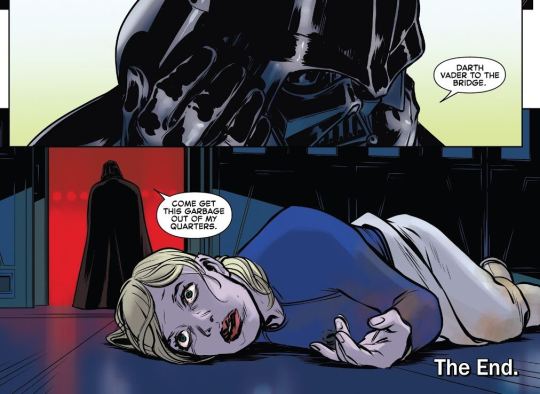
Ok, that’s a tall order. Here are points that I find entirely problematic.
1.The Question of Agency:
The authors decided to give a voice, a narrative agency to a character that is presented as inconsequential to the story. She is an anonymous nurse, a dot, in the bigger picture of the Empire. Much, let’s say, like our current ST heroes: Rey, Finn, and Rose, who started as “nobody”, even more so in the case of Finn and Rey who have literally been deprived of their identities. You could think it’s cool to thus give a voice to this nurse. Even more so when you consider that throughout the comic, she is presented as downtrodden, poor, pushed over, abused physically and verbally, dismissed, and despised. Her employer disrespects her constantly, calling her “fool”, “idiot”, or “stupid”. He shoves her around, and also diminishes her job, calling it “not a real job” or insinuating that she does not do her job correctly. Cases in point:

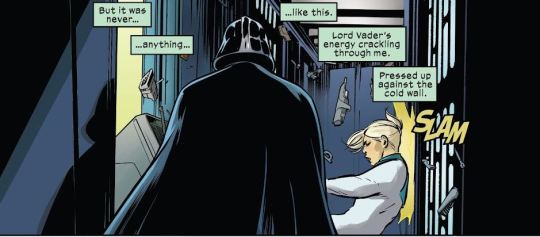


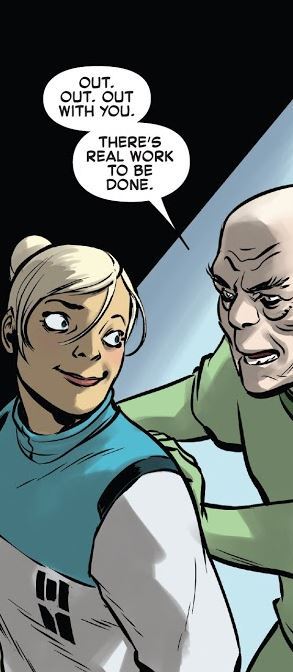
And what do we get in this story? A female nobody who starts asserting herself. Wow.
She tells her own story. First person narrative. She becomes an agent.
Look at the evolution of her daydream fantasies. She starts from damsel in distress who needs a man to protect her from her daily abuser

From nurse whose job means something, to a solid professional, and equal partner to her fantasy Lord:
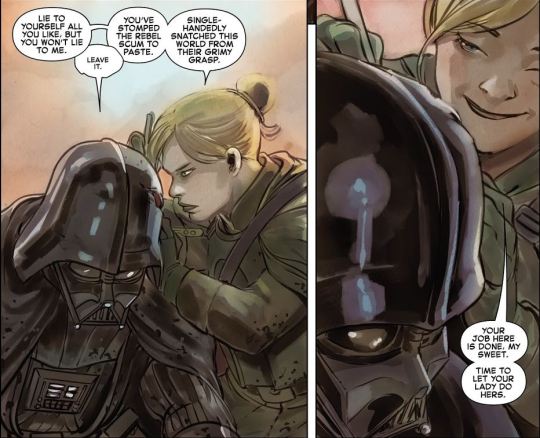
And finally a powerful woman in her own rights, even overshadowing her partner, and who is able to defend herself.
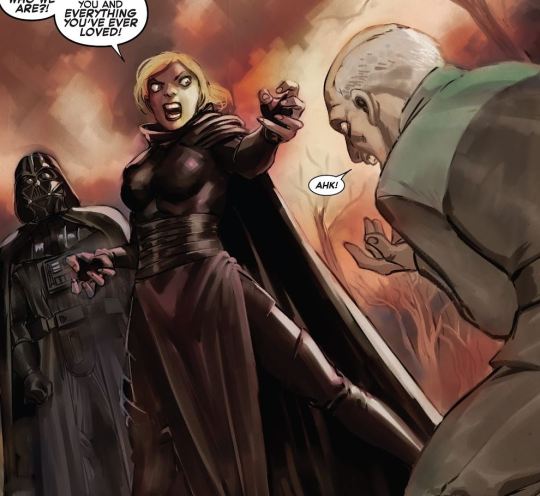
Which then matures into her mustering up the courage to speak for herself, and tell her feelings to the (unwilling) object of her affection.
Except that.... well...she is just presented as a massive psycho. And, ok, it’s fair, we all know that there are female stalkers, and that her obsession for Vader is totally crazy because she doesn’t know anything about him, and she actually fell for someone who was treating her as poorly as the others. But there is the malaise there... The mix of female empowerment and batshit craziness. That’s what put a lot of people ill-at-ease. I wouldn’t even call that subversion, because, dudes, what are we subverting there exactly. It’s not like women are not daily abused and treated poorly at work and in their relationships on a daily basis... And are we supposed to take that as a cautionary tale about fangirl craziness? Because, there again, why did they need to have that girl get such a shitty treatment all through the comic. It is like the comic says that she deserved it. In the end it’s not just Vader calling her trash. It’s also the doctor calling her trash for most of the comic, and even have her literally waddle in a trash compactor. Cause this was supposed to be subtle?
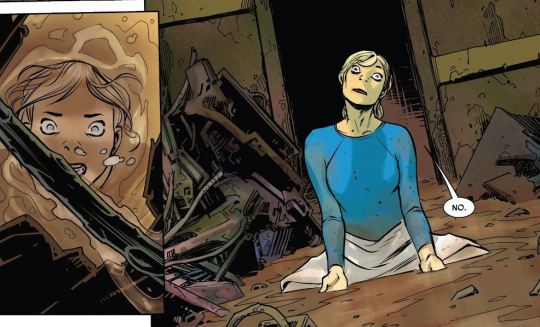
Like, fine, if it were only Vader calling her garbage because the man is just dead inside, which, fairly, is represented in the comic. But it’s just not Vader, it is the way the character is presented through the eyes of the doctor AND even through the eyes of a cartoonist who keeps on representing her with the stupidest darned faces.
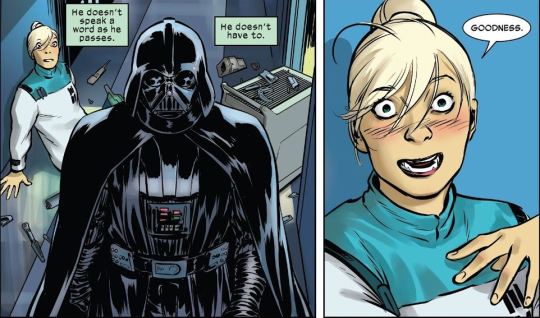
And there is no other viewpoint. Family, friends, other nurses or colleagues who could give us another idea about her. Or explain why she is like that. Nope. Basically, this woman is given a voice just so she can be cut off mid-sentence and made... fun of... I guess? Was that the author’s goal? Is it what we are supposed to feel? About this pathetic character and her pathetic life, dreams, goals, feelings, and eventual demise?
The “Subversion” of Female Romantic Tropes
Like ... LOL... How is that “subverted” anyways? But, ok, let’s go through them. It has all the classic elements of female literature.
The Cinderella story: nobody falls for high lord and expects to be swooped off her feet. Complete with ball scene, because, yes, why not? I give them a point, though, for the cool reflection on the ground which has her in her regular scrubs... BTW, Beauty and the Beast in the mix as well.

the nurse complex! Otherwise known as the Florence Nightingale effect. You know, woman is going to take care of the guy... They even made her a real nurse! Again, so subtle. Couldn’t make her any other profession and still be victim of this complex.
the reference to so-called “trashy” female lit, think bodice ripping, Harlequin, and their infamous covers. Even the title of the comic: “Tall, Dark, and Handsome”
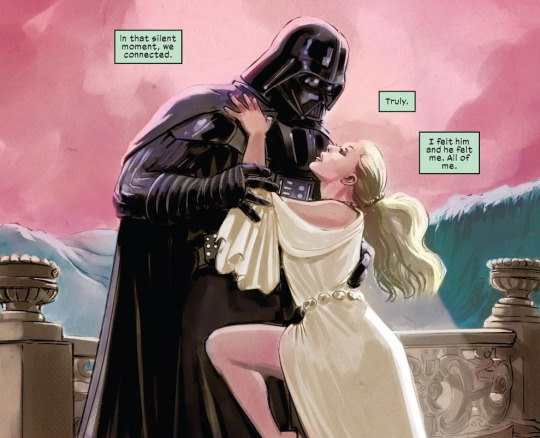
The effing Phantom of the Opera!
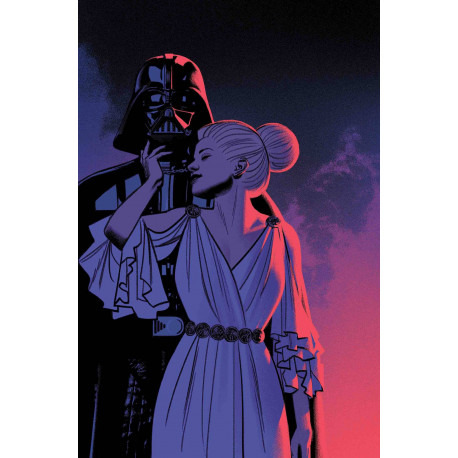

and of course all the female discourse about love, because, yep, trashy: “kindred spirits” etc...
And again, how are we supposed to interpret it? Well, hang on, this woman, remember, is a bat-shit crazy deluded psycho, who has delusions about life and love. Oh, and the doctor says she is trash. And he throws all her stupid gory, disgusting trickets in the trash. Oh and also Vader says she is garbage. Well. Ok. So, I guess all of that which mattered to her, all her ideas, all that she loved, was just that. Trash. Garbage. Well, take that, you female reader!
But wait, it gets even better...
Star Wars is just trash!
Yep, because on closer look, most of the fantasies this woman has are very Star-Warsy. I am floored that they are actually trashing these:
Anakin and Padmé’s Naboo scenery, green, lush, terrace, nightgowns...
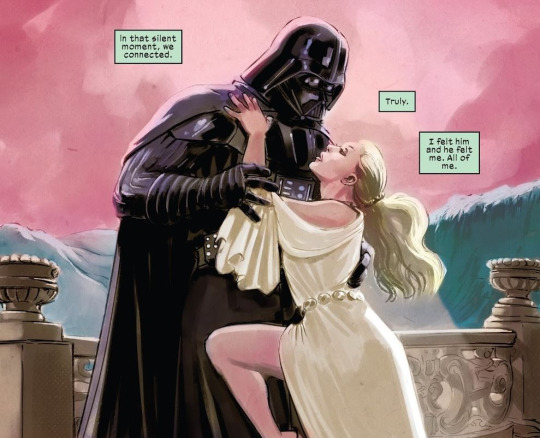


The scene when Anakin learns about Padmé’s death:
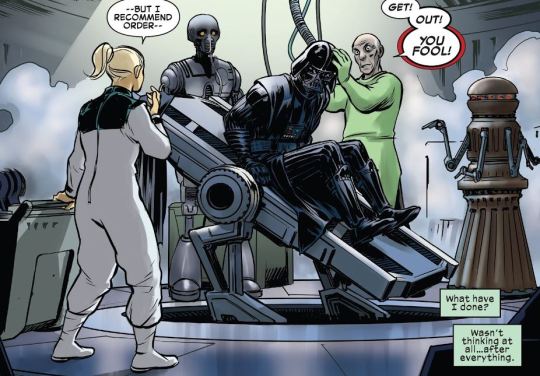

and of course, the one that you were not expecting... Reylo... “You are not alone”

Again, why is this problematic? In itself, it is fine and fair to be making fun of trashy female literature and campy romance novels, it is also fine to make fun of crazy stalkers, and it is also fine to be making fun of Star Wars. So why does it feel so icky in this comic somehow?
You can’t help but feel disgusted when you consider how poorly this woman is represented. There is not one aspect of her life that is not ridiculed. And again, this is about a woman who has NOTHING. They could have the girl fall in love with Vader and being killed by him because he is a cold-hearted machine. He killed his wife, the love of his life, so yea, of course he will feel not a pang of remorse or hesitation at killing this nobody who thinks she is in love with him. But they did not need to make fun of the very little she had in her life: her dreams. Her effing dreams. Plus the crazy stalker psycho. And the crazy face. And the fact that again we are talking about a woman, who had NOTHING. No family, no connection, no friends, no respect at work, not many possessions except her sad little Vader treasure chest.
And again, context. Here we are, reading a Star Wars comic where a lot of fanboys have been using the EXACT same terms to ridicule women in the fandom. Especially in the Reylo context. Trash. Garbage. Crazy bitches. Ridiculing theories about ... well, well, ain’t it a sweet surprise... Phantom of the Opera, or Beauty and the Beast parallels with Reylo. I’ll be damned. It feels crazy awkward, if you ask me. I mean, again, it’s all fair, but you don’t do that when you are in the midst of a toxic fandom war.
So why do I give zero F... about it in the end?
If some antis in the fandom saw that as validation, well, let them have their moment of happiness. It won’t last. We can give them that.
One, I don’t think for one second that it means anything about what will happen in the ST as far as Reylo is concerned. Again, they are even making fun of Anidala in the comic, and dude, that thing happened. As my good friends from @lordsofthesithpodcast would tell you after their glorious SWCC panel : Romance, these ships belong in Star Wars.
Two, as I highlighted in the introduction, this belongs in the Dark Visions series. It is meant, in my own opinion, to be disturbing and unhinged. Not sugar coated. So maybe the whole point was shock value. Mission accomplished. It was poor taste again given the context and the awful treatment THEY (and not just Vader) give their female character, but yea, dark visions. Not Star Wars Adventures. You have to look at the target audience and everything.
Three, if it were not for the in-your-face references to female tropes, I actually took most of it as a critique of fandom in general. The problem is not that she is a fangirl. There are some crazy obsessive fangirls, mind you. The problem is that they are making fun of all things female on top of that. But, remove the romantic aspects. Couldn’t that apply to fanboys as well? I could totally picture a cadet, or some other young imperial, developing the same crazed obsession over Vader. And it was just as toxic. And, tbh, it could very well be. Collecting trinkets is not just a girl thing, and after seeing with my own eyes the tons of merch purchased by fanboys at the recent SWCC convention, or the obsessive way some guy could talk to you about Vader and the minute trivial details in his life, or that they are the only ones understanding the guy, well yea... it works...
I’ll even go a step further. I wondered for a sec if the whole thing was not even a critical meta about the franchise as a whole. Let me explain. Some fanboys have complained about the femininization of the franchise, that is “polluting” the shades of Pemberley, I mean Star Wars. Claiming that what is happening right now is utter garbage. Also also, I have another possible reading which has the nurse representing the current state of the fandom and how crazy obsessed they can be over a franchise that some currently view as tired and dead inside (especially since it has fallen into the fold of Disney). Representing the unhealthy relationship between the two. And guess what, it doesn’t end well for the fandom. Who will never get what they want.
I will finally quote this from Chuck Wendig who was fired from the project and came up with that particular comment on Twitter, and which actually seems to go with how I tried to read it myself:
Apropos of absolutely nothing, my issue three of SHADOW OF VADER was about a toxic fanboy (a morgue attendant on the Death Star) who became obsessed with Vader. (And it didn’t end well for him. Er, obviously.) I thought it was good and I’m sorry you won’t see it! Onward we go.
I think they kept some of the original idea from Wendig, but it took a turn for the worse. It would be great if the authors cared to explain about their intent for this piece if any. I am not saying they should. I actually totally respect and support full freedom of speech and authorial choices. It is our choice, then, as a reader to read or not the material we don’t care about. I am just curious to know their opinion I guess, and I was not able to find any comment online. If anyone has a reference, I am interested...
In any event, I think everyone should read the comic for themselves if they are curious about it. Better to make your own opinion about it.
91 notes
·
View notes
Text
A Buffy rewatch 4x10 Hush
aka Tara Maclay has done nothing wrong ever in her entire life
Welcome to this dailyish text post series where I will rewatch an episode of Buffy and go on an impromptu rant about it for an hour. Is it about one hyperspecific thing or twenty observations? 10 or 3k words? You don’t know! I don’t know!!! In this house we don’t know things.
And today’s episode is one that I’d easily recommend to first time viewers as their introduction to what Buffy can do - but one where I’m also starting to notice my own fatigue about trying to hyperanalyze the show on this rewatch run. Sometimes you just gotta sit back and take a moment to appreciate the nice things in life. And by nice things, I of course mean Tara.

Hush was nominated for an Emmy for its writing, and that’s significant, because it marks the show’s only Emmy nomination in what people consider to be major categories. I guess it’s also sort of an ironic twist that it’s the episode that lacks any dialogue for most of its run time that gets nominated for best writing, especially on a show that was largely known for creating its own language and voice… But that’s sort of the point. (And it’s the kind of ironic twist that Buffy would certainly appreciate.)
Through Hush, Buffy successfully challenges its own tropes and boundaries while maintaining its tone throughout. Quippy dialogues are replaced by visual gags, thanks to acting, editing, and some fantastic musical score choices. This is easily a top 5 episode contender for most of the fandom, and many people’s favorite of the entire show.
That being said, it did bring to the surface my aforementioned critical fatigue thanks to scenes like Xander thinking that Spike killed Anya. The ensuing fight, and the relief upon realizing that Anya is alive is supposed to prove that Xander truly cares about her… and then is immediately undercut as the two very unsubtly leave for a quickie.
I find that I have a much harder time getting into Xander and Anya’s relationship now, but that scene also tells me that the show is aware of how dysfunctional this relationship is still. Much like the swelling romantic music that played during Xander and Cordelia’s early make-out sessions, here, it feels a purposeful exaggeration to lampshade the romanticization of certain tropes.
Needless to say that at the time I interpreted all as romance played straight, but I enjoy discovering the nuance in these stories now. It’s far from being a subversion, and there is very much a genuine relationship build-up happening between the two, but there’s also a level of self-awareness about where they are now, currently.
I’m also still overthinking Buffy’s dream opening. “When I kiss you, it’ll make the sun go down.”

Is this a foreshadowing for Buffy about Riley’s hidden side, and who he is in the dark? Is this referring to how she talked about having a boyfriend in the daylight now, and does this line then mean that after kissing Riley, she’ll have to integrate him into the Slayer part of her life as well? Or is it just about her fully letting go of Angel and how that day has now truly passed?
What does it all mean???
And if the Wicca group is also the Lesbian Alliance that Riley put up the banner for in the other episode (I’m like 99% sure that that was the actual intent here, even if it’s not a textual equivalence), what does it mean that Tara feels uncomfortable expressing herself in that very environment? Is this a social commentary about silencing the most vulnerable in a community of those it’s supposed to represent?
See, this is why my brain is a mush trying to interpret all these themes and metaphors and probably foreshadowing. I need more processing time.
So instead let’s go into a lighter theme: communication.
There’s an obvious thesis here about how language often makes a barrier to communication. As a result, going non-verbal actually helps Buffy and Riley get over their little dance of blabbery, and even Xander and Anya get their groove back because… Actions speak louder than words? I guess?
But admittedly my favorite thing about this concept is that it’s essentially what informs Tara’s entire character. She stutters. She has valuable input, but she either gets ignored and is spoken over, or she’s put on the spot where she has trouble expressing herself.
Think about that. A character that will become an integral part of the series over the next two and a half seasons, and she was written with this specific episode’s themes in mind. That’s kinda neat.
We also see her running away from the Gentlemen, unable to speak, as her frantic knocking and non-verbal cries for help get ignored by the rest of the dormitory. A fellow student in danger who the rest of her peers are too afraid to open their doors for. What if they become victims too? What if she is the monster?
Everyone except Willow. (Fortune favors the brave and all that.) And while individually they’re easy targets, together, combining their powers, they’re strong enough to protect themselves against the threat. A community of two.
And then they have that adorable talk by the end of the episode, and Tara tells Willow that she’s special. Which is Willow’s catnip, so she’s probably already in love.
I was also wondering about Tara looking up Willow’s room in the dorm directory. (Kinda like Spike did Buffy’s in The Initiative? That’s a weird parallel.) She seemed rather convinced that Willow had powers based on a rather short group interaction… but then I also remembered, that Tara’s magic is pretty intuitive. She’ll spot Faith being in Buffy’s body right away later in the season based on her aura, despite never meeting Buffy. So of course she senses that Willow’s like her.
Alright, so it’s a gaydar.
And I’m just so excited that Tara’s here??? In a show that’s full of flawed characters who will each do some questionable shit, Tara is like an actual ray of sunshine who you can always count on to not be terrible. I love her and I can’t be held responsible if I end up talking about her in most of these posts from now on.
You’ve been warned.
(Fun Fact: the first room we see the Gentlemen visiting is Room 118… So I looked it up, and I know you’re wondering it too, but no, Seeing Red is not the 118th episode of the show. It’s the 119th. 118 is Entropy where Tara and Willow get back together. So there’s that.)
5 notes
·
View notes
Text
Fall 2018 Anime Overview: Continuing Series- Golden Kamuy Season 2 and Banana Fish
Golden Kamuy Season 2

If you enjoyed the first season, this is pretty much more of the same, so check out my review of season one to know what to expect.
Though I guess you could say this portion of the season DOES lean even harder into weirdness than the first one did. There’s not many anime where you’ll see two dudes having the time of their lives modeling fashionable outfits made out of human skin, which include...crotch appendages...only in Golden Kamuy y’all.
Interestingly bizarreness tends to overlap with queerness a lot in this season and its hard to know how to feel about it. For instance, it’s definitely an unexpected revelation that dudes are attracted to Lieutenant Tsurumi like whoa.
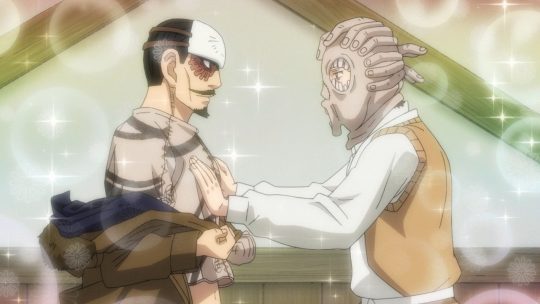
IDK apparently he’s a catch. Half of his subordinates are in love with him. It’s handled as comical and of course the dudes are mentally unbalanced weirdos (as is everyone in Golden Kamuy except Asirpa and Sugimoto only sometimes) and one of them dies, but the show is never overtly mean to them either. Nobody acts disgusted about it and when one character observes the attraction, he basically shrugs about it.
Satoru Noda apparently also REALLY loose with his fixation with dudes muscles with this part of the story, to the point we got the beef-cakiest hotsprings episode I’ve ever seen, which includes an extended fight scene where the male characters were naked throughout. There’s also an entire scene where apparently otter meat is an aphrodisiac that causes the dudes to be really into each other, so they engage in nearly naked sumo wrestling.
This is all clearly supposed to be wacky and funny, but at the same time it’s pretty clear the mangaka must REALLY LIKE drawing these scenes of muscular, naked men, and I support him following his dreams. Also I won’t deny it’s refreshing to see a hot springs episode where not a single woman got objectified, but there was dude oglin’ a plenty. It healed me a little.

I guess while we’re talking about this show and its weird relationship with queerness I should reporting that my prediction was right and the trans woman I mentioned in the previous review did become an ally. Her transness hasn’t been bought up again (though for some reason the subs decided to switch to “he” despite sticking with “she” before) and her role is pretty minor, she does reveal she’s skilled in both cooking and surgery (because she likes dismembering people) and talks about how great it would be to see people murdered every so often, so pretty much more of the same.
And that’s really all there is to say. Golden Kamuy has only gotten weirder and the plot only more convoluted (I’m starting to have a hard time keeping track of the characters tbh), but it’s an entertaining story and there’s still characters with resonance and heart underneath it all (the scene where Sugimoto discusses his trauma from being in the war with Asirpa genuinely tugged a heartstring. These two are still great and have really settled into a kinda of adorable dad-daughter dynamic at this point) and the historical and cultural research that went into this story is still amazing.
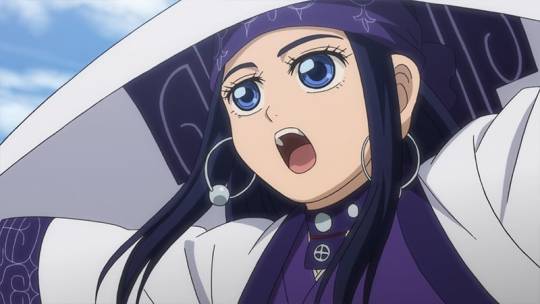
I can tell the anime’s still skipping a lot of the manga (most of volume 7 was completely skipped), but since the English release of the manga is so slow, I’m happy to watch it in the meantime. It helps that the show has a bangin’ soundtrack and and it managed to pull its ginormous cast together for some truly exciting and action packed final episodes that left me eager for more.
Banana Fish (13-24)

Again, if you read my review for the first half of the show, you can basically expect more of the same, both with the good and especially the bad parts. We do get more downtime with Ash and Eiji’s relationship, and they continued to make me think this show would be so much better if it focused more on these quiet scenes rather than on piling as much trauma on Ash as it possibly can.
I think this second half did allow me to see what was compelling about Ash and Eiji’s relationship and why it’s stayed with so many people. When Ash explained that he’s finally found someone who will love him without expecting anything in return, so of course he’s willing to do anything for that person, that got me in the heart. Ash is someone who has either been viewed as a threat or someone to exploit- he’s especially used to being treated like he’s nothing more than a body, a receptacle for desires. Eiji isn’t afraid of Ash, or in awe of him, and never asks anything of him other than for him to be okay and by his side. Ash genuinely can just be a dumb teenager with him while he can’t with anyone else. Eiji is an outsider, to Ash’s gang-bangin’ world, to his culture in general, and that allows him to see Ash as he truly is, just a kid who needs to get out of this mess.

The romantic in me really loves that concept, and as an ace person, I especially connect to the underlying implication that Eiji is a romantic partner who isn’t going to demand sex from Ash or try to force him into it. Though Ash’s implied desire to avoid sex almost certainly stems from trauma, I know how he feels in a broad sense. And I think it’s a thing a lot of women can relate to even if they aren’t ace, wanting to find a relationship where they aren’t used or objectified, so it goes back around to how Ash acts as kind of a representation for the anxieties and desires of (likely) the mangaka and many women despite being a male character, and I still find that very interesting. The scene where Ash has a complete breakdown and screams at his rapist while laughing hysterically was really affecting.
So there’s moments of real resonance here, but is it worth the bullshit surrounding it, which includes every single gay man being represented as a rapist, to the point a gay bar is connected to a child porn ring? The nasty implication that gay sex is inherently evil and non-consensual, and Ash and Eiji’s relationship is only okay because they’re not doing it is very strong, and as much as this ace appreciates a romance that doesn’t require sex, I don’t want it THIS way.
There’s also some SERIOUS anti-Semitic bullshit that I can’t believe MAPPA didn’t edit out in a couple episodes. Like it would have been so easy to cut. Also some more pretty rough scenes of black men being murdered (they’re extras this time at least, and the main black dude for this part of the anime miraculously manages to both survive and not be an offensive caricature. Also his name is Cain Blood which is the best name in this story, and possibly ever).

The second half of the anime also involved some of the more absurd elements worsening. I got REALLY tired of every character commenting on how hot and amazing Ash is like. I GET IT. Also Ash’s life of being sexually exploited somehow gives him the ability to seduce any man holding him captive, and every bad guy is down for raping a teenage boy, I guess. It’s actually again, a little surreal to see these tropes with a male character. I’m used to seeing hot female characters who’ve been through sexual trauma and have magic seduction powers and are endlessly drooled over...I almost want guys to watch these segments so they can see how uncomfortable it feels when the tables are turned.
There’s also some really good examples of ACTUAL jarring tone shifts, where the anime really fails to land some of its attempts at a funny, light moment in the midst of really tense and tragic situations. I think it’s possible the manga managed this better, but I can’t imagine the “joke” where Ash has to crossdress and a male doctor gropes him and Ash punches him out cold and his friends chortle and tell him he’s not a gentle woman could ever be done in a non jarring way. Like, I don’t like sexual harassment humor in anime at the best of times, but it’s especially bad when the person who is harassed has been raped more times than he can count. We’re expected to take that seriously, but not this, because Ash is in a dress? It’s also like, appalling that his friends who are fully aware of his history would laugh about him getting assaulted again. It’s a moment that feels like it comes from a completely different anime.
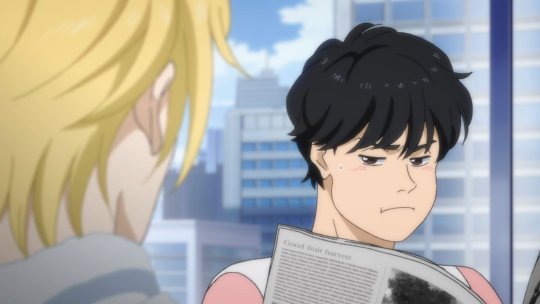
So um, yeah. My conclusion is those resonant moments are not worth the bullshit. The ending really cemented this for me. I had an (admittedly overly flippant) reaction that kind of sums my feelings up. Let’s just say I HATE meaningless cruel tragedy for the sake of tragedy, and I especially hate the implication abuse victims can never find happiness.
I can’t say Banana Fish is an anime I’ll think fondly of or recommend. I do still find the discussion about it interesting, much more interesting than the actual story (as presented in the anime, again, haven’t read the manga), tbh. And I can see the seeds of a good story there, and I can understand why fans would want to see a reboot that truly modernized the story, cutting out the worst stuff and giving it a better ending, while keeping the resonance of the main relationship and the good characters (I really did like Sing, and Yut Lung was interesting. Shorter and Skip both deserved way better. Also Jessica, who at least got to do something besides be victimized at the last minute. One whole female character got a few moments of agency. Hallelujah.) Maybe someday it will happen.
In the meantime, there’s a bunch of cool articles on Banana Fish that are worth a read. All of the pieces published on animefeminist as well as this post on Otaku, She Wrote are really informative, illuminating, and break down a lot of the issues I found here.
12 notes
·
View notes
Text
Review: The Nutcracker and the Four Realms [Spoilers]
Hey, everyone! So today I decided to go see Disney’s newest release, The Nutcracker and the Four Realms!
Some of you may recall that I’m a rather big fan of the original ballet and was quite disappointed about how little the trailers and promotional materials for this film resembled that very ballet, so I went in with my expectations ridiculously low. Because of this, I was able to see some good in the film, which I’ll go into under the cut, but for those of you who wish to avoid spoilers, I must be frank that The Nucracker and the Four Realms is a mixed bag at best. Those who love the original ballet and book will likely hate how little the movie respects its characters and story, and those who don’t love the ballet and book might find it to be a rather standard action-adventure fantasy film for kids with few elements that weren’t done better in other movies. It’s not as god-awful as The Nutcracker: The Untold Story was or anything: there were good ideas here and there...but overall, I’m afraid I can’t recommend The Nutcracker and the Four Realms to anyone.
For those of you who don’t fear spoilers...a cut!
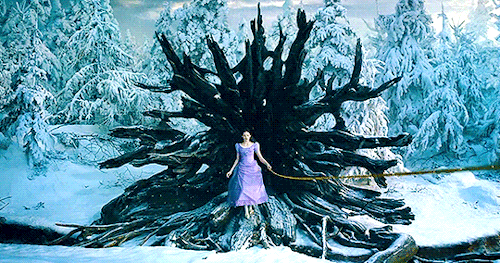
The Good!

+For the most part, the first fifteen minutes of this movie (taking place in London) felt the way a Nutcracker film adaptation should. There were nice Christmas colors, sparkling holiday decor, and an elegant party full of swirling gowns and happy children. Admittedly I probably would’ve preferred it if the story had taken place in Russia (like the ballet) or Germany (like the book), or even a vaguely European-ish setting without naming a specific city, but hey, can’t win ‘em all.

+All of the actors chosen I thought were pretty good choices. Morgan Freeman made a great Drosselmeyer (though I wish he’d had more of a role in the story), Helen Mirren and Keira Knightley are always good talent (though I’ll come back to problems I have with their characters later), and even the actor they chose for the Nutcracker, Jayden Fowora-Knight, was good enough that I wouldn’t mind seeing him in something else. But for me, the actor I loved seeing the most was Matthew Macfadyen as Clara’s father, who was easily one of the best parts of the movie. This could also be considered a bad thing, as he’s criminally underused, but it doesn’t change how nice it was to see him. (I can only hope that Keira and Matthew were happy to see each other on set again, even if they had no scenes together -- garg.)
+The music was pretty well-handled. James Newton Howard did a good job of not just running all of the usual tunes into the ground -- he gave us a nice haunting remix of the Dance of the Sugarplum Fairy during an eerie scene in the Fourth Realm, used the Battle track excellently during a confrontation with the mice, and arranged the Overture perfectly in the opening panning shot (which admittedly looked too CG for my taste, but still communicated the location and mood well).
+Misty Copeland’s ballet performances were excellent. She truly was a joy to watch every second she was on screen.
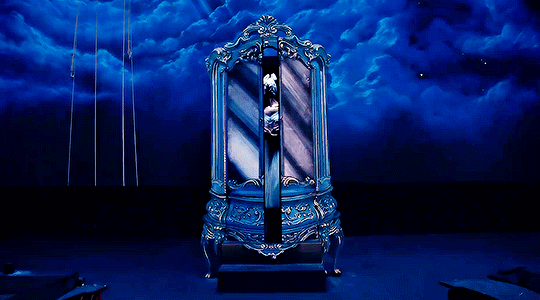
+The costumes for the most part were well done, as were a lot of the visuals. I have some issues with them that I’ll come back to, but honestly, the majority of them worked well for the characterizations and mood the film was going for.
+Directly connecting Clara to the magical world she enters is, in principle, not a bad idea, nor is the idea of her arrival in that world being more than just a fun finale. A battle in a magical realm will always be more interesting than one done in your living room. I also like the idea that Clara’s facing her real-world problems through her fantasy and that she’s more active in the story...I just would have written those ideas very, very differently.
The Not-So-Good...

+The script. And I mean absolutely everything about it. There is so much wrong with this script and the concept behind it that I will have to make separate bullet points in order to go through all of the problems I had with it:
The characters are beyond underdeveloped. Although I think Helen Mirren, Keira Knightley, and Jayden Fowora-Knight were good casting choices, they honestly had very little to work with. Mother Ginger was supposed to be a villainous sort, but from the very beginning, she never came across that way, despite the script’s and the actors’ best efforts -- hell, in a flashback we see that Clara’s mother actually sort of resembled Ginger! That sure isn’t a hint to who’s really trustworthy or anything. The same can be said for Sugarplum -- honestly, did anyone really not guess that she was the fake-out villain all along, especially after how long Disney has been beating that particular dead horse of a trope? As for our “Nutcracker” Phillip, he really has little autonomy in the story given that he basically follows Clara’s orders as a princess and then, mid-way through the story, we’re supposed to believe that he’s now following her out of real devotion and caring, even though their relationship isn’t given the time and scenes needed to show their growing bond. Drosselmeyer as I said was barely around: we learn that he basically raised Clara’s mother, which you would think means he had a role to play in the Four Realms, but nope! He doesn’t appear anywhere until the end except through his owl familiar that...does absolutely nothing during the entire story. I barely remember any of the side characters in the Four Realms, and I just finished watching this movie about an hour ago. Despite being some kind of a mechanical genius, Clara is amazingly bland. She says she doesn’t know who she is or what her place is, and yet Phillip goes on about how confident she is and basically everyone around Clara showers her with praise. She’s smart enough to teach the great inventor Drosselmeyer himself how to fix something and also tough enough to kick a tin soldier in the face during the climax...but that, in the process, kind of makes her boring and one-note. I never feel like Clara is in any danger or puts herself at any great risk because we never see her in a situation she can’t handle. Even when she’s “trapped” by Sugarplum, it’s at the top of a tower decorated with a chandelier and windows she can easily get out of, so she just jerry-rigs herself and her fellow prisoners a way down after a pointless touch of moping. (I mean seriously, you couldn’t lock her in a dungeon?? With LOCKED DOORS AND WINDOWS??) And really, hasn’t this archetype Clara’s fulfilling been done to death already? Rather than have her be yet another “girl ahead of her time” (one basically just like her mother, which doesn’t exactly make her special, then), why not have her be nothing like her mother? If Clara had been more like her sister Louise and yet expected by everyone around her to be like her mother, wouldn’t it have made her realizing she has everything she needs inside of herself mean that much more? Wouldn’t it have shown her the value of her own worth if she’d failed to live up to everyone’s expectations at first, rather than her be heralded as “truly being her mother’s daughter” and clearly being so from the beginning?
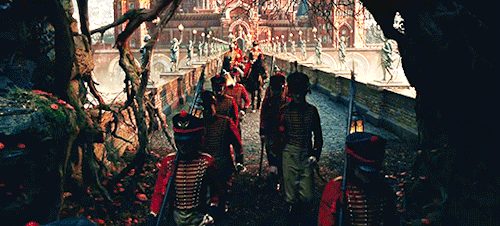
The Four Realms itself doesn’t really make that much sense. Not only does it resemble Narnia (snowy magical forest that you enter through a magical doorway, time moving differently than in our world, lost human ruler returning to ascend to the throne) and Oz (being split into four parts and, like Oz the Great and Powerful, a ruler of one of those lands being painted wrongly as the villain by another who actually wants to take over everything) a little too much for my liking, but I can’t even figure out its rules. For one, the film can’t seem to decide whether Clara’s mother Marie (nice nod to the original book, actually) created the land or discovered it. In all of the summaries I’ve read, it says that Marie created the Four Realms, and her identity as an inventor would seem to justify this, but in the dialogue, Sugarplum says she discovered each land, and brought its citizens to life through her engine invention thing. Yet if they’re all dolls brought to life and made large by the engine, why are they all doll-sized when they go through the clock to peek in on Drosselmeyer’s party? And how much of that world is actually based on our real world? The film at some points tries to make connections to Clara and her mother’s real life by having Clara and Fritz try to catch a mouse in their attic, depicting a Nutcracker ornament in a flashback, and showing Fritz receive a Nutcracker that resembles Phillip for Christmas, but the film drops the ball in having any of those touches actually mean anything. There are ways you can weave the real world into your fantasy land in a meaningful way -- the film could have had Marie taking inspiration from her real life when she made this make-believe world or even represented Clara’s inner turmoil by making the Four Realms completely make-believe, but instead it just comes across as muddled and odd.
Speaking of Clara’s mother Marie, I really don’t like the fact that I have to insult a dead woman, but...screw this woman! She makes this entire world and then, as her dying wish, tells her adopted father to only have her middle child discover it by leaving the key to her music box there? What, did Louise not deserve to be a princess too? Did Fritz not deserve to be a prince? Your husband, who called you the LOVE OF HIS LIFE, doesn’t deserve to know? Oh, but they’re not like Clara -- they’re not clever and special and different like you and Clara. That’s why you told Drosselmeyer that Clara was your greatest invention, because clearly your other two non-main-character children don’t count. Bite me.
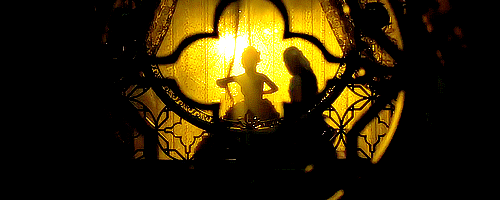
The story crafted doesn’t fit the constraints that a Nutcracker tale must operate inside -- namely, the film sets up the fact that this family is mourning the loss of their matriarch, and yet the entire story focuses solely around Clara. Yes, the original Nutcracker tale is supposed to be about Clara, the Nutcracker, and the Mouse King...but by adding the mother’s death and the arc revolving around Clara and her family coming to grips with it, the story’s basically torn between what it should be about versus what it is about. This family is broken and must be fixed: Clara going into another world that has no connection to anyone but her dead mother to “find herself” isn’t going to fix that. Therefore the central conflict and the driving plot have no connection. The film either needed to take out the family part of the plot or have the entire family discover this world together and connect through their adventures in it in order for this choice to make sense.
On the note of focus, “The Nutcracker and the Four Realms” is a misleading title. A better title would be “Clara, Sugarplum, and Their Dead Mother,” because that’s all that gets any real attention here. Phillip, rather than being a prince cursed into the form of a Nutcracker, is a toy brought to life that serves Clara (the real princess) and has no animosity for mice excluding what has been indoctrinated into him by Sugarplum. He even BEFRIENDS the Mouse King at the end. Yes -- THE NUTCRACKER BEFRIENDS THE MOUSE KING. ARE YOU F**KING KIDDING ME --? As for the Mouse King, oh ho ho....wait until you hear this. The Mouse King is not a monstrous, fearsome creature locked in battle with his foe, the Nutcracker: instead he’s just an ordinary mouse that fuses together with his subjects into this monstrous giant mouse shape. But they’re not really the bad guys -- no, they’re underlings of Mother Ginger, who’s a good guy. So the Nutcracker plays second-fiddle to Clara, and the Mouse King plays second fiddle to Mother Ginger. TWO OF THE MAIN CHARACTERS OF THE STORY ARE REDUCED TO GROUNDLINGS OVER HERE.
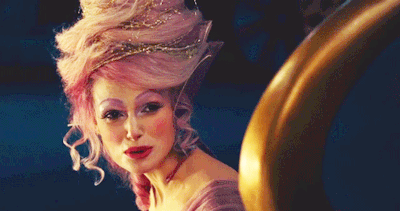
Sugarplum’s motivation doesn’t really make sense. She claims she’s taking over because Clara’s mother Marie left them and that hurt her, but...how do you go from feeling betrayed by your mother figure to “taking over the world”? Is it because the world is one your mother created and you want to destroy it because it reminds you of her -- wait, no, Marie didn’t create it, though, she discovered it, and you only really seem interested in going after Mother Ginger with any great passion rather than any of the other Regents...okay, is it that you were hurt by your mother figure and so you want to create an army so strong no one could ever hurt you again -- wait, but everyone seems to like and trust you, so there’d be no reason for you to fear that and it’s not like you built up that lack of trust earlier...okay, is it that your mother figure chose her real family over her make-believe family and so you want to get back at the family she chose over you -- wait, no, you locked Clara up but you’ve barely even tried to take any vengeance out on her and you looked almost horrified when Clara outsmarted you... Yeah, what I’m trying to get across is that Sugarplum as a villain really doesn’t jive.
Because of the lack of character development and the many disparate plot elements fighting for your attention, no relationship in this movie comes across as particularly heart-felt or genuine. We get almost no build-up for Clara and her father’s disagreement before they part ways (and that confrontation has very little fall-out, so it feels hollow); Sugarplum’s affection for Clara seems so cloying and she is so obviously the villain that it makes it difficult for the audience to see any kind of bond forming (honestly, wouldn’t a kind of buried-deep resentment been more interesting, given that Sugarplum knows all about Clara but Clara knows nothing about her?); and there are so few moments building up Clara and Phillip as equals and friends that the scene where Phillip encourages Clara to stay by saying he didn’t follow her because she’s the princess basically comes out of left field. Even the relationship between Clara and her mother, which is so central to the movie, doesn’t ring true for me because they are so similar. Everyone remarks on how much Clara is like her mother, but that means that there’s no interesting interactions between them. Clara is just a Marie 2.0, rather than her own person, and Marie’s advice to Clara almost seems obvious: if Clara’s so much like the mother she admired, there’d be no reason for her to be as self-doubting as she is. If the film even just tried to show how much Clara still has to learn at some point, that relationship would’ve been that bit stronger, because it would mean that Marie saw something in Clara that no one else did, not even herself.
+Moving on, even though the ballet routines were pretty, they came out of nowhere. Rather than integrate dance seamlessly into the plot by having Clara be interested in ballet or something, the sequences only served to be fluff pieces plopped down into the middle of scenes that don’t connect to anything else going on. It just felt like the filmmakers were trying to remind you that “oh yeah, this is based on the Nutcracker -- I know it doesn’t resemble the Nutcracker in plot at all, but it’s definitely based on the Nutcracker!! 8D”
+The editing at points in this was really choppy and messy. There were quite a few tracking shots that got way up into the actor’s personal bubble, even in scenes that weren’t supposed to be uncomfortable or weird. For example, there’s a moment when Louise, wearing her mother’s old dress, comes to check in on Clara and their father -- the camera keeps the reveal of what she looks like a surprise until after showing the father’s awed reaction for a long moment, but because we the audience have never seen this dress or even a picture of the mother wearing it, we feel nothing when the dress is finally revealed. There’s no emotional gut-punch that would’ve been there if we saw a familiar dress on someone else, so the editing choice seems pointless.

+Even though most of the costumes were pretty, the hair and make-up choices were sometimes bizarre, even for characters that were supposed to be pretty. When Sugarplum does Clara’s hair up all princess-y, it’s supposed to glamorous, but it just looks ridiculous. I also wish that the Regents for the Flower and Snowflake Kingdoms had looked a little less cartoonish -- did we have to have the Snowflake guy have icicle bangs messily dribbling into his eyes? Admittedly both him and the Flower Regent were pretty useless, but their silly designs didn’t exactly make them more appealing. There were also two unfunny “comic relief soldiers” with their hair drawn badly onto their heads, and I don’t know, it just wasn’t a particularly appealing look for characters we theoretically are supposed to like watching. Louise also has a rather odd hairstyle in her first appearances that doesn’t communicate her supposedly feminine and mature character, which is supposed to be a contrast to Clara, but still likable -- instead it makes her look over-the-top and silly.
+Even though many of the visuals were nice enough to look at, there wasn’t much that I haven’t seen before. If you edited footage of the Four Realms alongside Wonderland from Alice Through the Looking Glass and Oz from Oz the Great and Powerful, I think you’d be hard-pressed to tell where one starts and another begins at points. The Christmasy colors you see in the “real world” really should have been dialed up for the fantasy sequences, but instead, there’s not much of a shift excluding seeing people with pink cotton candy and flowery vines for hair. Many of these supposedly doll characters don’t even . resemble toys with hinges or knobs or anything: they basically look like oddly dressed humans. Even a color palette shift would have been helpful in separating the two worlds -- for instance, having a more white/brown/yellow color scheme with pops of red and green for the real world and more of a pink/purple/blue/white color scheme for the Four Realms might have made each one more visually distinctive. It also would have made Clara pop out more if she’d been dressed in a more “ordinary” color scheme (like a pale yellow) that made her stand apart from the most fantastical backgrounds (perhaps touched with a cool lavender or light blue).

At one point I tried to pretend that this film wasn’t an adaptation of The Nutcracker. I asked myself, “if this wasn’t based on the famous ballet you love so much, would you like it? Could it stand apart as its own thing?” And unfortunately, the answer I kept coming back to was, “...It can’t be its own thing, because it’s taken too many ideas from other sources that did them much better.”
A young girl discovering a magical world while wandering around a strange house? The Chronicles of Narnia: The Lion, the Witch, and the Wardrobe.
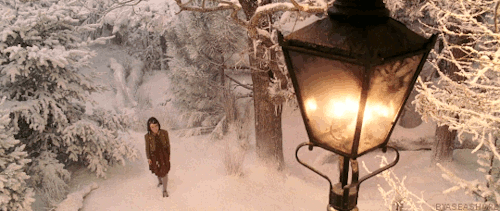
A whimsical land of fantastical creatures that can only be saved by a special child? The Neverending Story.
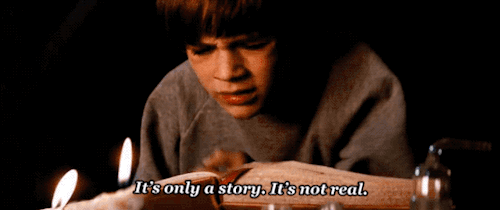
A coming-of-age story where a girl navigates a world of fantasy and adventure to find herself? Labyrinth.

A world of magic and science where good and evil are not what they seem and an ordinary girl can be the princess of a lost kingdom? Castle in the Sky.
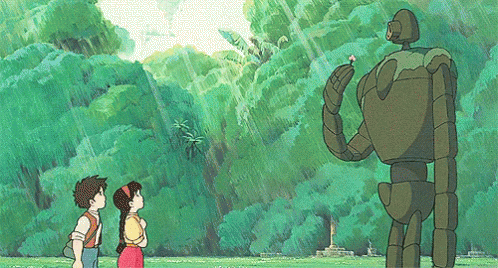
And honestly, if all I can think of when looking back on the movie I just saw are the ballet it took its title from and other better movies...what does that say about The Nutcracker and the Four Realms? It breaks my heart, as I so wanted Disney to adapt this classic story, but I wanted a full-length animated musical -- something in the vein of Disney’s Sleeping Beauty -- where any changes made to the plot and characters enhanced the story as opposed to distracted from it. Maybe someday, way down the road, Disney will realize their mistake and do The Nutcracker the right way...whether they do or don’t, though, I’m afraid this Nutcracker movie is doomed to fade from public consciousness, and even though there clearly was hard work put into it, thanks to the overall vision and script, the finished product is so forgettable that I can’t say it deserves better.

Overall Grade: D
#the nutcracker and the four realms#reviews#disney#spoilers#opinion#oh boy here i go#analysis#the nutcracker#the nutcracker and the mouse king#fairy tales#ballet
24 notes
·
View notes
Photo

[[ This post contains my review/analysis of the Forgotten Realms/Drizzt novel, Timeless, by R. A. Salvatore. As such, the entirety of this post’s content is OOC. ]]
Genre: Fantasy
Series: [As of yet unnamed]: Book I | Legend of Drizzt #34 (#31 if not counting The Sellswords)
Publisher: Harper Collins (September 4, 2018)
My Rating: 3.5 out of 5 stars
Review Title: Salvatore’s Best Work to Date
Additional Information: Artwork for the cover of Timeless and used above is originally done by Aleksi Briclot. This post is very long and CONTAINS SPOILERS. Furthermore, this discussion concerns topics that I am very passionate about, and as such, at times I do use strong language. Read and expand the cut at your own discretion.
First, before I get into the breadth of this post, I feel that I need to make it clear that the success of Timeless most likely has no bearing on whether there will be other Forgotten Realms novels by authors aside from Salvatore. It was much speculated by many longtime fans of the Forgotten Realms novel line that if Timeless is successful enough, that Harper Collins would contract with other FR authors as well. While it would be nice if this were the case, numerous sources within the publishing sphere have indicated that such a development is highly unlikely.
Now, on to Timeless. If you’ve followed me for a while, you’d be right to suspect that there is some degree of sarcasm in my review title for this book. Indeed, a statement like that from me normally would be followed by, “but that’s not saying a whole lot”. However, with regards to Timeless, I am completely serious (insofar as my review title is concerned anyway). I feel that Salvatore has achieved a new height with Timeless that I, quite frankly, had not thought possible for him. After over three decades of writing and over 30 books of following the same formula, Salvatore has finally produced a book that makes me hopeful for his future works in the series. Overall Timeless is a decent book, with improvements in writing style, storytelling, characterization, and consideration of the Realms as a whole. Nonetheless, my hope is a cautious one, as the potential for a lot to go wrong is still there. However, Salvatore has also shown potential for a lot to go right. I’d really like to see the future bring much more of the latter than of the former.
Timeless represents a turning point in the Drizzt saga, as well as for the Forgotten Realms as a whole. The Drizzt franchise has been licensed to an external publisher for the first time since its conception, and with that many changes have come. Salvatore has declared that as far as he’s concerned, the “Legend of Drizzt” is over, and that Timeless represents a new story, that anyone could leap into. While this is certainly true at some level, I feel, after reading the book, that it may not stand alone anywhere near as effectively as it stands as part of Drizz't's overall story. Perhaps stating that the legend of Drizzt ended with Hero is not altogether accurate.
I’m a huge critic of Salvatore’s work, as well as being extremely critical of it. Perhaps sometimes I’m critical to a fault, but hey, I’ve got a lot of emotional investment in one of the characters he’d created (can you guess who? ;P) and I’m passionately in love with the world that character lives in. However, it was love of the character that led me to my love of the world, and if I didn’t love the world as much as I do, I might’ve fallen out of love with Artemis Entreri, especially after the treatment he’d been given in the Homecoming Trilogy. I’d first branched out into reading other FR novels because I wanted to learn more about the world that my favorite character lives in, so that I could better understand and portray him. What came as a result of me broadening my horizons was so much more than a deeper sense of connection to Entreri. This world became my escape of choice, one that I want to understand and know every aspect of, and the place in which I want to tell my own stories. The Forgotten Realms novels were more than simple entertainment for me, they were encyclopedias full of facts that I could compile about the world that I love, and no fact was too small for my fascination. Then, a strange thing happened (or perhaps not so strange): the more I’d read, the more I’d wondered how Salvatore became the most successful Forgotten Realms author. The Forgotten Realms franchise as a whole has a reputation for having third-rate fantasy, which is really unfair to many of the authors who published works within it, and I can’t help but imagine that this reputation has a lot to do with the fact that the Drizzt books are the most known out of the FR franchise. I do believe that the Drizzt books rightfully deserve to be called third-rate fantasy, but I’ve railed on Salvatore often and profusely in the past about what made his writing poor so I don’t need to do it again here. Timeless is a big change. As I was reading it, I was reminded of the better works in the Realms. Or, perhaps I should say, of the best works, which is high praise for Salvatore indeed, as while other low quality Realms novels are pretty forgettable in their specifics, passages from my favorite Realms novels stick in my mind, embodying within their evocative word choices the beauty and magic of the Realms. Although nothing in Timeless has made me feel transported to the side of the character, for once I could feel the tug, and that tug is the potential that never existed before.
Many times during my reading of Timeless, it felt like I was reading a different author -- a noticeably better one. I didn’t have (and still don’t have) an explanation for why this is the case, despite my having always held out a sliver of hope that Salvatore’s writing would improve. Over all of these years and too many books, I’d been disappointed over and over again. The best case scenario that I could hope for in reality was that Salvatore couldn’t get any worse, but oh boy did he get worse in the Homecoming Trilogy. Now that I’d suddenly gotten what I’d come close to giving up on, I’m really not sure how to handle it. I’m happy of course, but I want to know why and how it happened, and most importantly, if it is sustainable. Was it due to Salvatore himself, or his publisher? Unlike Wizards of the Coast, publishing books of all kinds is what Harper Collins does, and they’ve got more than enough expertise in publishing successful novels. As such, Harper Collins would have personnel who are much better equipped to assist Salvatore with all facets of his writing, and I’ve no doubt that they have editors who are better writers than Salvatore himself. I’ve seen enough good authors to freely admit that the greatest boon to their work wasn’t their own creativity but rather the contributions of their editors to know just how valuable a good editor can be. Perhaps Salvatore’s “leveling up” is due to having access to better editors. If this is the case, I do hope that they continue to help him as they did in Timeless.
I suppose it wouldn’t be fair to Salvatore to completely attribute all of Timeless’ writing improvements to his editor(s). He had to be willing to listen, to accept that what he’d written could be improved, and this wasn’t something that I’d thought he was capable of, given the thin-skinnedness that he routinely displayed on social media. Salvatore was willing to get rid of a lot of the tropes that I’d criticized him for, to the point that there are very few occurrences of what I’ve given the term “Salvatorisms”: his “cliché stable" was practically empty throughout Timeless and that alone was a huge improvement. I was so thrilled that “six hundred pounds of panther” didn’t appear even once, nor did the inane adjective of “killing” with regards to Guenhwyvar’s teeth and/or claws. Granted, Guenhwyvar didn’t have much “screen time” in Timeless, but that certainly didn’t stop those descriptors from showing up in the past, so this change is a great sign. Even more exciting than that is not a single appearance of the “how [character] [action]ed!” sentence construction reared its ugly head. This sentence construction is one of the worst Salvatorisms as well as being one of his favorites, so it’s a HUGE deal to me that it is completely absent in Timeless. For those unfamiliar with what I’m talking about, I’m referring to the overuse of expressions like, “how he howled!”, pervading Salvatore’s previous books. Now, for the first time as far as I can remember, “how he”, “how she” and “how they” are FINALLY used correctly to convey by what means and in what manner someone did something, instead of being this vague exclamation about something doing something to a degree that we’re supposed to know about because there’s an exclamation mark ending the sentence, but in fact we don’t know anything about because the quantification is completely empty. I honestly didn’t think that Salvatore could get to eliminating this so quickly AND so thoroughly. I’d expected to see a reduction of it like what happened with “six hundred pounds of panther” appearing less and less before disappearing completely. To the total elimination of the incorrect exclamations involving how things occur, I say this: Hallelujah and huzzah!
Of course, some aspects of Salvatore’s diction could still be improved. He is still exceptionally fond of using “magnificent” and “fine” for more things than he should. The former occurs 17 times throughout Timeless, which is more than in many of the previous Drizzt novels. Furthermore, 14 of those occurrences could really be substituted with more evocative and appropriate descriptors. The latter appears 53 times, and that includes the adjective forms. I didn’t count how many of those “fine”s were used as ineffectively as the 14 “magnificent”s but suffice to say, there are too many. But this isn’t a big deal and is an easy thing to fix. Even if Salvatore didn’t want to spend the time to expand his vocabulary, thesauruses are easy to come by, and even should he misuse a word, he has very capable editors to help him find an appropriate synonym.
While I certainly appreciate Salvatore changing things up, at times, I felt that he tries too hard in this regard, namely by attempting to change or create things that are fundamentally unnecessary. There were two main instances that stuck out to me. The first was the application of “fashioned”, as it applies to a gesture and then a facial expression. The former of these usages is less egregious, but the latter is just strange and awkward, as though Salvatore was trying to write in a fancy, archaic and/or eclectic way that ultimately just fails to become anything but pretentious. What makes it even more strange is that these awkward uses of “fashioned” occurs twice in one chapter, and then never appears again aside from the proper way in which the word should be used. Unfortunately, the same can’t be said of the other tryhard new word application: “eyeblink”. This word rubs me the wrong way for several reasons. It’s redundant, it’s awkward, it’s contrived, it’s a poor rip-off from the much more poetic measurement of time “heartbeat”, it doesn’t have any precedent in FR literature, and it just isn’t necessary. I don’t know why Salvatore felt the need to interject his own measurement of time when there is a rich plethora of it in FR, or why he’s apparently decided that he doesn’t like “breath” as an expression of a short amount of time. I couldn’t find a single usage of “breath” in Timeless following the conventional method in FR literature to mean a very short amount of time. I wouldn’t mind Salvatore changing things up and adding new things if they weren’t so artificial, and the word “eyeblink” is like an ugly speed hump there to trip up the brain as it rolls along what would otherwise be smooth passages.
So, with the negative writing style details out of the way, moving on to the positives. Unlike previous books in the Drizzt series, Timeless feels like something that Salvatore actually put in effort to write. It felt like he actually associated some degree of emotional attachment to what he was writing, rather than making a desperate bid to have all of his characters stick out in Forgotten Realms lore and/or reap in as much $$ as he could because it was his last chance to do so. While his better descriptions aren’t at the point in which they stick in my head, seeing them for the first time did make me raise an eyebrow and nod approvingly, and I do remember that they exist, but sadly, not well enough to find them again without a re-read. Salvatore does a lot better job of showing and not telling, although he still has room for improvement. Regardless, similes and metaphors color the spoon-fed flat details like how many drow soldiers marched in whose compound or how many demons stood against our heroes who are fearless because we are told, not shown, that they are fearless. Additionally, Salvatore actually tells us more details of what the characters look like. It’s still not as specific as I’d like, but knowing, for instance, that Zaknafein had/has short hair and that both he and Drizzt have less angular features than other drow is a big plus from vague or absent descriptors. Previously, we’d take the “canon” appearance of the characters based on the artists’ interpretations of them. For instance, Zaknafein was thought of and portrayed by many to have long hair with a partial-ponytail because that was how Todd Lockwood painted him, when apparently, canon is very much otherwise. We’d also not known anything about what Drizzt looked like, other than that he’s “handsome” and has purple eyes. While “less angular” still leaves much to be desired in terms of description, at least it’s more specific. A detailed accounting of someone’s facial structure has the potential to be boring, but that potential doesn’t have to be realized. As an example, perhaps Salvatore could drop a line about the shape of father and son Do’Urden’s nose and how it’s like or unlike drow noses, thereby giving us more details while at the same time providing some drow lore. Or, perhaps the next time that Drizzt quirks an eyebrow, there could be a line in there about how the shape disrupts what normally has the grace of a willow branch. I don’t know, just throwing examples out there. Although I do like “beautifully curving skull” for Jarlaxle’s head, as it conveys both his own sense of narcissism as well as his attractiveness, it leaves much to be desired in terms of details. Is Jarlaxle’s head actually prettier than the average drow head, or is that all within his own mind? We might never know.
Speaking of drow lore, Timeless does give us more of it than we’ve seen in a long time, from Salvatore at least. Part of this is because the endless machinations of the Matron Mothers of Menzoberranzan don’t provide anything new even when it’s a different Matron Mother doing the machinating. In Timeless however, we are given even more forgettable names, but we’re also provided with more glimpses into the detailed lives of the residents of the City of Spiders. We see that the priestesses of Lolth engage in activities other than praying to their goddess and having sex with each other in their endless power struggle. We meet female drow who are not just basically replicas of one another, and male drow aside from the most powerful and notable who might have more of a role to play in their society than their society would care to admit. We see more parts of Menzoberranzan than just the greatest of the noble houses. We even travel to a drow city that isn’t Menzoberranzan. We learn details such as grease and Gelatinous Cube goo being used as hair styling products by drow (or just Jarlaxle). And, of course, we’re told a lot more about the Do’Urden household, and although this topic is as uninteresting to me as Drizzt is, I still found it intriguing when Briza was revealed to be fathered by Uthegentel Del'Armgo, that Nalfein was fathered by Rizzen and inherited his lackluster nature, that Malice had killed her mother to succeed the position, and that Malice is small for a drow (smaller than males even). I’d be interested to learn who fathered Dinin and Maya. I’m not really sure what purpose it serves for us to be told that Malice is very good at sex, just as I’m not sure why it’s pertinent that Zaknafein is as well, but hey, I guess drow society needs something to gossip about. It’s probably part of the whole “sex sells” tactic, and at least it’s better than the fetishization of lesbians that Salvatore routinely engaged in in the past. Not a single incident of gratuitous sex between drow female and yochlol in drow female form occurs in all of Timeless, or any unnecessary female/female sex scenes for no reason other to titillate certain readers who enjoy the objectification of a type of people. I’m really proud of Salvatore for this, I hope that this is a trend that will continue. In any case, previously, most of the “behind the scenes” aspects of Lolthite drow societies had to be excavated from other FR books and/or resources, such as the War of the Spider Queen series, the Starlight and Shadows series, and the Underdark/drow-related D&D supplements. While Timeless doesn’t paint the full picture itself, it does a decent job of fitting into all of it if not tying it all together, and that is far more than I could say of any previous Drizzt book. In fact, the first part of the book reminded me of what it felt like when I was reading about the Underdark for the first time. After being tired of and frustrated by Salvatore for 30+ books, I’d long forgotten the sense of wonder and fascination I’d felt that first time. I think that it makes a certain degree of sense for each author who writes about the Underdark to introduce it in their own way, and although Salvatore’s was the first introduction I’d read to the Underdark, Homeland fell flat on its face compared to what Elaine Cunningham does in Daughter of the Drow. I can’t say that Timeless’ introduction to the Underdark is as good as that of DotD, but this time Salvatore has come much much closer.
Some of the details that Salvatore provides in Timeless made me recall something from one of the Underdark sourcebooks, but I can’t remember which one it is. Specifically, that sourcebook states that drow who have “off color” eyes like blue or purple are not purebred drow throughout their entire history. They’d have a surface race’s blood within their ancestry, most commonly a surface elf’s. I can’t help but wonder if Salvatore is going in the direction of a “grand reveal” that Drizzt had a surface ancestor. This would certainly explain the less angular features that he and Zaknafein share, especially if there was, say, a human ancestor in their bloodline. Furthermore, the drow as a race are horribly inbred, given how they have elitism within elitism. It is the case in our world that “mutts” are stronger and healthier than purebreds, and if we assume that that’s the case in FR genetics as well, Zaknafein and Drizzt being drow “mutts” would certainly partly explain their physical superiority among the drow. I’m a bit torn as far as my feelings regarding Salvatore linking Drizzt’s trademark purple eyes, with the supporting not as angular features, to canon established in previous source material. On one hand, I always support and clamor for Salvatore to make his books less insular, and a willingness to step back from always making everything contribute to Drizzt’s special snowflake status would show Salvatore to be not as shallow and egotistical as I’ve come to believe him to be. But ultimately, I think that I hope that Salvatore doesn’t go this route with Drizzt and Zaknafein. The “it was always meant to be!” reveal would certainly be mind-blowing to sadly most of Salvatore’s fans, but there’s a lot of problems with this trope, other than that it’s incredibly cliché. The idea that “goodness” being bred into him rather than a choice that he made would really rob Drizzt of the significance of his morality, as well as convey the really problematic message that what we are is more predetermined by accidents of birth than by our own choices. From an in-universe perspective, it would also imply that purebred drow are inherently evil, which has been a consistent theme in Salvatore’s books. However, the history of the drow indicates that this isn’t the case, but sadly, through the intentional erasure of non-evil drow deities, Salvatore has warped the canon. Most of the contents of this paragraph are speculation though, and it could just be that Salvatore isn’t going anywhere with Drizzt’s and to a lesser degree Zaknafein’s curious physical characteristics. It could just all be a coincidence, and I do hope that it is.
So, while I like a lot of what Salvatore has done in terms of worldbuilding in Timeless, there are also things that I really don’t like. The biggest of these is what I feel to be him taking liberties with things that he shouldn’t take liberty with. It’s one thing to state that Bregan D’aerthe, which not-so-coincidentally happens to be an anagram of the words “Baenre gathered”, is one of the possible ways to say “assassins for hire” in drow, but it’s an entirely different thing to inject modern real world political things into an established canon. I’m referring specifically to this:
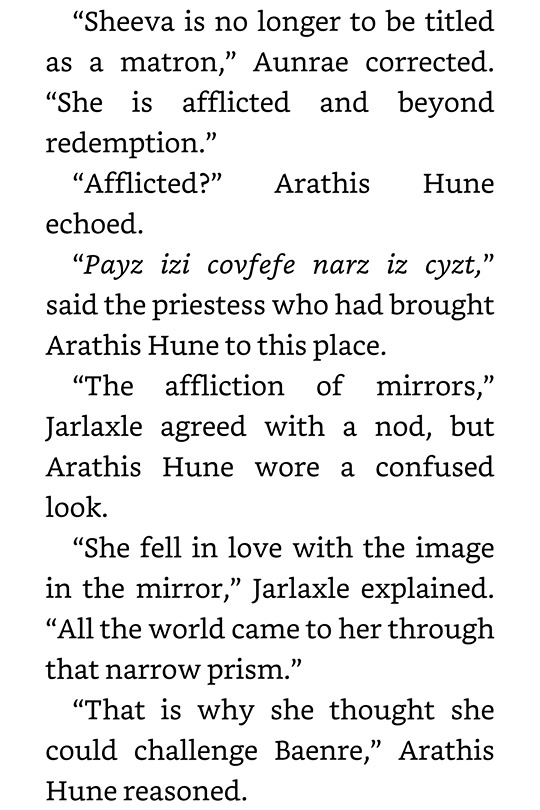
Don’t get me wrong, I LOVE that Salvatore did this. I can’t express how thrilled I am at seeing him show a spine and take a stand against something blatantly wrong. While Salvatore expresses sentiments that I agree with on his social media, he hasn’t previously put his pen where his mouth is, and in fact has done quite the opposite. I’m referring to the aforementioned fetishization of lesbians as well as the omission of male lgbt+ characters in a world whose creator has stated that pansexuality is the default sexuality and that the concept of discrimination based on sexuality is nonexistent. So, I’ve always sort of looked at Salvatore’s “social justice” stance with more than a little skepticism, and as much as I’d like to believe in him, because that would definitely make my life easier, I couldn’t. What he’s done here is impressive because it’s the sort of thing that could get someone into a lot of trouble. He’s risking losing his conservative readership with such a move, whereas previously his writing has just always been catering to the masses, avoiding confrontation, and directed wherever the money will come from.
So then, what’s my beef? I realize this makes me sound like I’m never going to be satisfied but I possess a great deal of the love of the Realms as a whole, a love that is fueled by the contributions of the array of creatives. The Realms is a beautiful quilt comprised of pieces created by different people, each one a different style, meshing together to make this whole big amazing work of art. Although I love what Salvatore has done, I wish he didn’t do it here. I wish that he’d done it in his own books, not in the one that’s part of a shared world. What he’s done with the covfefe thing in a Forgotten Realms novel is like if he’d taken a sharpie and written “Fuck Trump” on that quilt. The sentiment is good, and most of the people that created the quilt probably agree with him, but it doesn’t change the fact that he’s rudely put a jarring mark on top of the quilt. From this day onward, not only does FR canon state that the drow language contains a word that’s just all-too-coincidentally the same as the nonsense construction created by the angry tangerine currently in charge of the United States, the word is also apparently now part of an established drow concept. I don’t really care for drow, I think they’re edgy and overrated, but I feel bad for what this does to them. It makes them even more silly and artificial. Not quite to the degree of Twilight’s sparkling vampires yet but certainly trending that way if this keeps up.
While we’re on the subject of the drow, let’s talk about demons, since the two seem to be closely linked, although I can’t figure out why the drow haven’t learned from millennia of dealing with demons that it never works out in their favor. The demons are either too incompetent and stupid to get things right or are too chaotic and unpredictable to do what the drow want, or some combination of both ends up blowing plans involving them in the drow machinator’s faces. It’s truly strange that Lolthite society has survived with all of their self-destructive tendencies, courting with demons being one of them, especially since being elven folk, drow aren’t particularly fertile, even with the massive amount of sex that they have, especially when, according to Salvatore, a great amount of that sex happens between priestesses and/or with yochlols, and there are only so many hours in a day to do things. All said, the drow should be at least endangered as a species. I get that they’re supposed to be chaotic but it’s gotten past the point of starting to get ridiculous that this species survives in the cutthroat Underdark. Sure, there’s the whole “it’s magic!” argument, but really, that doesn’t make it an excuse for lazy worldbuilding. I can get following this route when you’re just starting out, but the Drizzt books have been out for nearly three decades now and D&D is even older. Salvatore is definitely not contributing to the practicality of this race with yet another major plot that uses demons. Besides, Rage of Demons was so 2016. I get that the novels have been put on hold for two years but it’s lazy to just pick up as if those two years haven’t happened. They have, and the Realms have experienced changes. The demon rampage should be behind us, but apparently, they’re still very much a threat to the world thanks to Salvatore. He really needs to stop doing this, he doesn’t get to dictate the flow of the Realms, WotC does, and even though WotC gives him leeway due to his moneymaking prowess, it’s still incredibly egocentric of Salvatore to command a SHARED world to move, or more accurately adhere, to his pace and his events. Heck, Salvatore isn’t even consistent with himself. I can understand the demon threat still being an active concern if the Demon Lords had succeeded in getting out of the Underdark, as the Out of the Abyss adventure proposes an alternative ending scenario in which heroes don’t save the world and Faerûn is ruled by demonic influence. But the thing is, we saw Drizzt strike down Demogorgon, and we witnessed other demon lords retreating back to the Abyss. I get that demons aren’t very smart, as they seem even more interested in pursuing self-destruction than the drow, but it should be obvious to anything with even a pea-sized brain that if the biggest and most powerful among your kind can’t succeed at something, the chances are that you, an average whatever, aren’t very likely to succeed at it either. All in all though, it doesn’t make sense for the drow to keep using demons and it doesn’t make sense for the demons to keep being willing to be used in the same repeated ploys over and over again. The demon trope is a crutch that is being leaned on by someone too lazy to create a new one. Along the same lines of the repetitive plot is the yet another attempt to take over the surface world. Matron Zhindia’s name (had to triple-check that was the correct one) is as forgettable as all other priestesses of Lolth who have tried to take over the surface world and/or hunt down Drizzt because after the first ones to do it, namely Yvonnel the Eternal and Malice, it’s really a case of been there, done that. Do we really need to see it happen (and inevitably fail) again?
I’ll break up this negativity with some Timeless plus sides. First, on the whole, Timeless does feel a lot more like a Realms novel than most if not all of its predecessors. Salvatore’s tendency was to insulate his corner of the Realms so much so that he’d ignore the existence of aspects that should have a significant bearing on his plot. Namely, the erasure of drow deities other than Lolth, notably the siblings Eilistraee and Vhaeraun, is especially glaring. Given the activities that followers of both engage in, it was very unlikely that Drizzt, or even Zaknafein, weren’t discovered by them, and brought to be among other drow of like mind. My suspicion is that acknowledging the existence of those drow would be taking away from the special snowflake status of Drizzt as the only goodly drow. What was done was petty, small-minded, disrespectful to the rest of the setting and honestly, pretty pathetic. However, and very shockingly to me, there’s a chance that Salvatore has done the unthinkable in Timeless: he might’ve made an allusion to Eilistraee. Jeyrelle Fey, a member of Bregan D’aerthe, is described as a priestess of a goddess who isn’t Lolth, but Jeyrelle wouldn’t give the details when asked by Zaknafein who her patron was. Of course, she could just as easily be a follower of Kiaransalee, another evil drow deity whose existence wouldn’t threaten Drizzt’s "special snowflake only goodly drow" status. Or, even more strangely, Jeyrelle Fey could be a follower of surface elf deity Sehanine, and as unlikely as it is for a priestess of Sehanine to be in Bregan D’aerthe, I wouldn’t put it past the guy who elevated a minor and unrelated nature goddess to a position that should’ve been occupied by the drow deities whose portfolio specifically included non-Lolthite drow. Still, I’m holding out hope for the best case scenario. Yvonnel 2.0 is still receiving spells from presumably Lolth, but even she recognizes that she shouldn’t be in Lolth’s favor due to the degree to which she betrayed Lolth. And really, Yvonnel 2.0 shouldn’t be in Lolth’s favor, for Lolth has dropped followers who haven’t denounced her quite as flagrantly as Yvonnel 2.0 had. It would make a lot of sense for Eilistraee to take note of and to take Yvonnel 2.0 under her wing, but I fear that Salvatore will pull the whole “Lolth loves chaos and loves this the most because it was too unpredictable even for her” card. The thing about Lolth is that, despite what she supposedly stands for, in reality, based on the way that she’s portrayed by Salvatore, she’s more about absolute devotion and getting what she wants. Chaos would mean that things would work out roughly so that she gets what she wants about as much as she gets the opposite, but we’ve seen how badly she reacts to getting even a bit of what she doesn’t want. Someone like that is about order and absolute rule, not chaos. I would like to see Salvatore accept and incorporate the existence of the entire drow pantheon into his work. I’ve always believed that acknowledging the presence of other goodly drow (or at least, not totally evil drow) outside of Drizzt’s immediate family would be a boon. If anything, it would be a great chance to make Drizzt special in a less artificial way. Especially now, as it begins to require a crane to suspend disbelief that Drizzt, and his widely-traveled and very knowledgeable friends have somehow been totally ignorant to two not insignificant sects of non-Lolthite drow. Now its definitely possible that our favorite Paladi... oh wait, uh, Ranger? has developed in a such a way that he might have some trouble relating to Eilistraeens and Vhaeraunites, I nonetheless could see him being excited when meeting them for the first time. He'd likely then feel awkward and/or put off by the specifics of their worship but even so its something that should happen. For instance, while Drizzt would certainly get along better with an Eilistraeen than a Vhaeraunite, I could see him being very uncomfortable with the ritualistic dancing naked under moonlight, as he is rather prudish. I could also see him being freaked out by the fact that male priests of Eilistraee would often participate in their ritualistic dances after using magic to change themselves into female forms. Furthermore, while Eilistraee’s followers tend to be a motherly type of matriarchal, Drizzt likely has severe enough trauma associated with matriarchies that he’d see issues where there aren’t any, which is something that he’s already prone to doing. Certainly, while experiencing all of these things, Drizzt wouldn’t be showing himself in the most positive light, which might contribute to why Salvatore is hesitant to incorporate Eilistraee and her followers into his story. But the story of Drizzt is in no small part about acknowledging your weaknesses and becoming better for it, or at least, it’s supposed to be about that, except unfortunately we’ve gotten a lot of acting out in immature ways and not really confronting existent issues but magicking in unnecessary ones for the golden boy to add to his accomplishments. Again, though, this would be a chance to set some of the past transgressions right, by finally bringing into the fold elements that should be a piece of any goodly FR drow’s history. Eilistraee’s song reaches every drow from the highest matron mother to the lowest male slave, instilling in each of them her wish for them to live in freedom and happiness. Of course, if additional development isn’t enough impetus, Drizzt being freaked out by Eilistraeens could make for some very hilarious scenes, and comedy is far from the lowest form of entertainment.
As for Vhaeraun, while Drizzt would appreciate the elevation of male drow to equal status as female drow, the specifics of what Vhaeraun stands for, especially as he’s represented in 5th edition, would be antithetical to Drizzt’s beliefs. Nonetheless, interacting with a Vhaeraunite would be an interesting moral quandary for Drizzt, for it’s possible for one to not be overtly evil, especially when he could relate to their desire to oppose and free themselves and others like them from the Lolthite matriarchy. Drizzt loves projects, and the starting material would be something that he could relate to better than he’d ever could and can to Artemis Entreri. There’s some great storytelling potential here if Salvatore would just embrace more of the Realms rather than shutting it out.
There’s a great deal of emphasis placed in Timeless about it being unknown where Zaknafein’s soul has been all of this time. Of course, it would’ve made the most sense that Eilistraee or Vhaeraun scooped it up before Lolth got her clutches on it, and that result would even be consistent with when Cadderly inquired about Zaknafein’s soul and found that it was in a “good place”. The Demonweb Pits could hardly ever be categorized as “a good place”. Salvatore could actually eliminate an inconsistency (and ho boy does he have so many inconsistencies already) by acknowledging Eilistraee and/or Vhaeraun, but I fear that the repetitive assertions of “it doesn’t matter”, as spoken by the Priestesses of Lolth as well as by the narration is just yet another nail in the coffin of the hope that Salvatore will acknowledge Eilistraee and Vhaeraun at last.
I’m always a little scared whenever Salvatore touches a character that wasn’t created by him. I still feel that it was self-aggrandizing when he had Alustriel Silverhand, who is usually very busy with large-scale threats to Toril as a whole, take so much of an interest in Drizzt that she agrees to personally teach Catti-Brie magic. It isn’t quite as ridiculous as relegating Elminster to that role, but I suppose if it were Elminster, Salvatore couldn’t hint to the average reader that there might’ve been something more than friendship between Drizzt and Elminster, although I’d have so much more respect for him if he was open-minded enough to do that. Unfortunately, Drizzt’s encounter with Alustriel took place during the over two decades of books in which the only creatures capable of non-heterosexuality were universally female. Oh, and pedophiles. This period was obviously not exactly known for its flattering representations. But I do think that incorporating the unfolding fate of Dagult Neverember into Timeless is a good choice, for not only does it introduce some intrigue that isn’t the typical and vastly overdone Menzoberranzan intrigue, it fleshes out a story in a way that is in accordance with what we’ve been told already. The stuff that happens in late 4th edition leading up to now has set Neverember up in a position where he isn’t well-liked by people in his world or those outside of it, and those who have been following the tale wouldn’t mind reading the details about his ultimate fate. I have a feeling that the events that happen in the cities, especially Waterdeep, was designed to dovetail with the events in the upcoming adventure, Waterdeep: Dragon Heist. Timeless does leave us wanting for details for a location as rich in lore as Waterdeep, and while other authors have done a much better job of painting the details of the City of Splendors in their works, I don’t really mind that Salvatore doesn’t meet their measure because of what we were given in Death Masks, as well as what I hope we will receive from the two Waterdeep adventures. I’m ok with Salvatore not trying to reinvent the wheel especially when said wheel is already so smooth and well-crafted already.
Even with a cursory view of Waterdeep, I’m glad that Salvatore dared venture within it. I can imagine that it’s a daunting task, not like the much smaller by comparison Luskan, or even the still under construction Neverwinter. By stepping into Waterdeep, he’s tapping into a rich Realms resource, and unless he’s desperate to make his mark on it like he did upon the Realms in the Homecoming Trilogy, Salvatore only stands to benefit. Using the location of Thornhold as a plot point is also a good move in my opinion, as it is a place with a history that’s been explored in other works, leaving behind a precedent that Salvatore can build upon instead of overwrite, and thus far, he’s done a good job of building instead overwriting. It’s also really refreshing to see Salvatore write a drow city that isn’t Menzoberranzan. With all the emphasis placed on Menzoberranzan, readers not familiar with the Forgotten Realms as a whole would likely think that it’s the ONLY drow city in the Underdark. Certainly, Menzoberranzan is arguably the most zealous Lolthite city, but if one has not read the War of the Spider Queen books, one might not even know about the existence of drow strongholds outside of Menzoberranzan. Of course there’s the chance that Drizzt-only readers of the Realms now think that Menzoberranzan and Ched Nasad are the only drow cities, which is a shame since Ched Nasad is no longer exists. However, it’s still great that Salvatore acknowledges Ched Nasad in his own publication, which is different from it appearing in a project he supposedly oversaw. With the existence of a second drow city, it’s easier for readers to imagine that there are third, fourths, and many more out there. Furthermore, Salvatore’s description of Ched Nasad, including how the characters in Timeless use its unique structure to do combat, is true to and consistent with how it was portrayed in the past. In all of this, it’s so good to see Salvatore work in conjunction with that which was left by his peers. I want to see him doing more of this sitting at the table expanding the tapestry, rather than writing his name in sharpie all over what’s been woven before.
One of the things that Salvatore does is serve up ridiculously souped-up versions of classics in D&D. Guenhwyvar is perhaps the best example of this tendency, as in addition to being immeasurably more powerful than a normal figurine of wondrous power, she’s also intelligent and possessing of free will. She gets to choose her owner, for even though the magic of the figurine has some ability to compel her, as we saw with Masoj Hun’ett, ultimately, Guenhwyvar calls the shots for herself. In Timeless, we see that Salvatore’s not done with the already overpowered Guenhwyvar, for Catti-brie the Chosen of Mystra is looking into ways to extend her ability to stay on the Prime Material Plane, which means that soon, we’ll see Guenhwyvar being even more unlikely to be matched by anything similar. Is it really necessary to make Guenhwyvar even more overpowered? As if that’s not enough, Salvatore has to change one of the basic and most commonly practiced D&D spells: Comprehend Languages. For those unfamiliar with D&D, Comprehend Languages is a first level divination spell that multiple different classes can take. Even though taking it would mean giving up one of your first level spell slots in lieu of a combat spell, many low level characters take it anyway because of how useful it is. However, being a first level spell, it should serve no more than what it’s intended to do, namely, help a character understand languages that they don’t understand, and even then only providing the literal meaning. What Salvatore has done with it is made it into something that should be a much higher level spell, because according to him, using it on a person enough times helps that person to learn the language. The quantity that constitutes “enough” can’t be all that high either, because Zaknafein hasn’t been with Drizzt and Catti-brie for all that long. Comprehend Languages lasts an hour, and there are only so many hours in a day to necessitate refreshing the spell. Catti-brie is probably high enough level enough of a wizard that casting all of those spells wouldn’t be a problem, but unless they were unnecessarily refreshing the spell before the duration wore off, which they’d have no reason to do, what Salvatore has done is make a basic spell into something much more powerful. What’s the point of learning languages at all if one could just be zapped with a bunch of first level spells to gain a language that would be appropriate to a situation rather than finding oneself with an inappropriate language for one’s station in life? This modification is just unnecessary and is one of those shared world elements that Salvatore shouldn’t be tampering with. It’s one thing that Drizzt in the novels is an unbeatable master swordsman but the character sheet version of him is a total joke by comparison, but it’s another to start giving plot armor to fundamental spells just because it makes Salvatore’s own job easier.
For better or worse, one of the most talked about aspects of the Drizzt books is the combat scenes. Some people think that they’re great, but I’ve never much cared for them even before I’d learned about how they’re written more like hockey games than sword to sword combat. There’s a lot of chopping and slashing using weapons that are designed to stab and pierce, and I’ve never understood why Drizzt specializes in cavalry blades when he’s never engaged in the style of mounted combat for which those blades are designed. But, I suppose in a world with magical weapons that aren’t breakable by mundane means, people can do whatever they want with their weapons, but that does beg the question of why they choose a specific shape of weapon other than to “look cool”, a factor which should be at the very bottom of any self-respecting martial artist’s list of priorities. Nonetheless, Salvatore’s fight scenes, especially ones involving drow, tend to be rote and formulaic. After the first few books or so, the fight scenes don’t offer anything fresh, and the many pages in which they’re described just tends to run on and not serve any purpose, especially when Salvatore often uses the same adjectives over and over again, i.e. “wades in”, “whirling scimitars”, “pumping arm”, “blades working in circles”, etc. This has gotten so bad in the Homecoming Trilogy that the phenomenon that I’ve come to describe as C-rated Hollywood stop-motion battle scenes was high praise. Timeless sees a marked improvement in that the fight scenes are truncated and punchier, and the aforementioned descriptors that are repeated endlessly throughout the series hardly make an appearance at all. A large part of this might be attributable to the fact that Drizzt isn’t the focus of Timeless, Zaknafein arguably has stolen that position. Furthermore, although we’ve never seen him use a whip before, the whip has suddenly become one of Zaknafein’s core weapons in Timeless, so much so that we barely see him in combat without one. He is a Weapons Master, so presumably he has expertise with a plethora of weapons, however the whip is portrayed to be such a central part of his fighting style in both his past and present incarnations that it’s more than a little strange that we’ve never seen him use one before. I suspect that this was done largely to change up the fight scenes, and honestly, it’s a pretty lazy approach. It was strongly implied that Zaknafein was the most proficient with dual-wielding fighting style, which is something that he’d imparted upon Drizzt through training. However, we’ve seen so much of Drizzt’s dual-wielding and are likely to see a lot more. Salvatore could’ve perhaps done some more research into various dual-wielding styles so as to distinguish between father and son, but instead he took the lazy route and introduced another inconsistency into a work that already has so many that it hardly needs more.
Speaking of inconsistencies, it’s strange and difficult to suspend disbelief when we see Drizzt struggling against two normal marilith demons when he’d defeated Marilith, the greater demon responsible for the name of her race. That happened when he didn’t have the new and improved Twinkle-reforged-with-Vidrinath. Along the same lines of it being difficult to suspend disbelief, there’s no tension when any member of the Companions of the Hall are “in danger”. Even before they’d died and come back to life, they’ve been in “mortal peril” for more times than I can count but always managed to survive. This pattern has continued to repeat, for as we’ve seen, even a literally world-shattering event designed to kill off short-lived races wasn’t enough to penetrate their plot armor. The scene with Regis and the Water Weird was neat, however I rolled my eyes at the “tension”. After everything that Regis had gone through, the suggestion that there was a chance that he’d die alone and undiscovered in the sewers beneath Waterdeep is just melodramatic. Were Salvatore R. R. Martin, I might’ve not been sure, but Salvatore’s star characters are immune to death to the degree that they’re immune to danger. The final thing that really makes me roll my eyes at is how we’re supposed to believe that Jarlaxle still has a chance of betraying the Companions of the Hall. I get that he’s supposed to be a very unpredictable character who ultimately is in it for himself but he’s shown himself to go to great lengths and expend unimaginable resources to help the CotH. He’s not only one of their most powerful and resourceful allies, but also one of the most steadfast. He might be the way he’s supposed to be with other people, but at least with regards to the CotH, Salvatore has made him so pathetically predictable that the CotH must truly be very stupid, or otherwise very hypocritical, to still suspect him. It’s really a shame what Salvatore has done with Jarlaxle, in his usual way of “redeeming” all the characters he’s made them flat, one-dimensional and calculable. Jarlaxle’s also lost a lot of his edge and sense of menace, he is far from what he used to be in the earlier books, and not in a good way.
On the bright side, the flashbacks to Jarlaxle and Zaknafein’s past are memorable. Perhaps this is because their story is one that Salvatore has wanted to tell for a long time and has already written most of, leaving him more time to tweak it before the finalization of Timeless. I feel that those scenes have more the mark of having been pondered thoroughly and extensively than the much more forgettable “current” events in Timeless. The thing that sticks out the most in my mind among those latter events are the fight scenes involving dwarves. Salvatore’s definitely a lot better at writing dwarven combat than he is at writing drow combat. His dwarven characters also talk a lot more consistently like Realmsians, which can’t be said of his other characters. It’s not as jarring as the dialogue in the Brimstone Angels books but, “You mean the dead guy out at the desk”? Seriously?
Zaknafein was my first favorite character. He gradually slid out of this role for me because he died before we got to know him very well. As time went on and I got to know the rest of the cast better, I became of the opinion that the only reason that Zaknafein remained cool was because he’d been dead, thus not giving Salvatore a chance to do to him what he’d done to Jarlaxle and Artemis Entreri. With Zaknafein’s resurrection, since I no longer cared about him one way or another, I was more curious than dreading to see what Salvatore might do to him. This hasn’t happened, and I hope for the sake of readers who love Zaknafein still, the ones capable of introspection and analysis, that it doesn’t happen. Other than the weird thing with the whip, Zaknafein feels about the same. Which, while it isn’t a bad thing, unfortunately, it isn’t really a good thing either for a character who has a book dedicated to him to not receive much development beyond what he was before. My feelings toward Zaknafein have evened to a bland neutrality that wasn’t piqued one way or another by the characterization in Timeless. For lack of a better word, Zaknafein is boring. His key defining feature in the early books was that he stood out from the rest of the drow in that he possessed mercy and wasn’t a senseless killing machine, except for when it involved Priestesses of Lolth. However, Drizzt has usurped the role of being the “only good drow” so thoroughly that not even his father can share the limelight. So, Zaknafein had to pick up a different defining feature that sets him apart from his son, and that defining feature turns out to be drow racial elitism. I’m actually quite pleased with this choice, because it does make sense for Zaknafein to have it. He might not think that “lower” lifeforms are worthy of death, but he had lived in a society that heavily indoctrinated that mindset into its members for centuries, unlike Drizzt who’d spent most of his time on the surface and experienced the pains of racism directly. What I also like about Zaknafein’s elitism is that it makes him similar to male drow from other FR series, namely, Ryld Argith from the War of the Spider Queen books. Ryld wasn’t a bad guy, but he wasn’t a good guy either, as I’d realized when he watched indifferently as a surface dweller died while he could’ve done something to save them. Zaknafein is perhaps more of a “good guy” than Ryld was, but he’s not Drizzt. This is actually really good that Zaknafein isn’t another special snowflake, but instead someone who could embody the mentality of drow males in general in the oppressive Lolthite matriarchy. It makes him more believable as a character, and his world more reasonable. While I said that the characterization of Zaknafein is boring, I do feel that it shows experience and maturation of Salvatore as a writer. I may just be being optimistic, but the sense I get from Zaknafein is that Salvatore’s years of writing Drizzt has taught him something that he applied to Zaknafein. Perhaps it’s because Zaknafein manages to be similar enough to Drizzt without being annoying, since he doesn’t preach and act sanctimoniously. I do wish that Salvatore would let Zaknafein become his own character though, without the none-too-subtle comparisons between him and Artemis Entreri. Jarlaxle may like Entreri as much as he likes Zaknafein, but the two are dissimilar enough that it’s really pushing a forced point to keep drawing the analogy. At times with Zaknafein, I also felt like Salvatore didn’t fully think out aspects of his character. For instance, Zaknafein professes to not care about House Simfray, and he shouldn’t given his character, yet he still wanted to personally slay Matron Hauzz for destroying “his” house. This doesn’t make a whole lot of sense because most if not all of the males of House Simfray, whom are the only things that Zaknafein cared about as far as that was concerned, were rescued and claimed by Bregan D’aerthe. It could’ve been just an excuse to kill another Priestess of Lolth, but Zaknafein expended a major bargaining chip with Jarlaxle to attain something that didn’t have that much value. It’s yet another typical Salvatore not well-thought out inconsistency.
All in all though, Zaknafein is all right. He might be being used as a symbol of regressive perspectives, but he’s mature enough to try to reconcile himself to literally a whole new world, while knowing when to hold his tongue. I got the feeling that Zaknafein was really trying his best, and although he gives in to his biases at times, the occasions aren’t extreme and are very understandable given his circumstances. I think that, whether it was by intention or not, Zaknafein is actually a good role model, because he never loses sight of what’s most important, and actually acts consistently with that fact. Even though it’s difficult for him to stomach the idea of his flesh and blood with an iblith mate, he doesn’t avert his eyes, but instead takes in the love that Drizzt shares with Catti-brie, and struggles to reconcile himself with it. When he knows that his beliefs don’t fit in a certain environment, rather than broadcasting them and/or forcing them down others’ throats, he attempts to keep them to himself. Zaknafein actually places the most important thing to him, his son, before himself, and is willing to go so far as to take himself out of that most important thing’s life because he thought that it was what was best for Drizzt. Drizzt, on the other hand... I’m not sure if it’s Salvatore’s intention to paint his golden boy in such a negative light, but I sincerely hope that it was his intention, because if he considers Drizzt’s behavior to be the right course of action, I’m going to be even more leery of people who try to emulate Drizzt.
One of the things that have always concerned me more than a little is how much of a pedestal Drizzt is elevated to in Salvatore’s novels, even when he does some really questionable things, and then those things are blamed entirely on the other party involved in the activities. Quite frankly, the thought of people emulating Drizzt terrifies me, because Drizzt has routinely engaged in activities that are very problematic. Even though he believes himself to be empathetic and sensitive to the needs of others, the reality is that his actions don't align with his statements. Drizzt is very egocentric, he surrounds himself with people who don’t do a lot of deep thinking and who only disagree with him on minor things. Other than the sanctimony and preachiness, Drizzt’s most problematic trait is that he’s convinced that he knows what the “correct” path is, and that the best way to “save” someone who has strayed from that path is to have them follow in his own footsteps. He has been through a lot, sure, but it’s still far from having experienced everyone’s hardships. Even though Salvatore would rather bestow upon Drizzt the opportunity to struggle with magically-imparted mental illness instead of exploring that experience through a character that would actually struggles with it (*cough* Entreri *cough*), Drizzt is still a far cry from being an expert on all things. However, Drizzt certainly seems to think that in his two short centuries that he’s seen everything, and his self-righteous diary entries are more insufferable than ever. Especially the one in which he goes on about how much he’s grown, it’s really hard not to roll my eyes and gag at it. Far from being shining examples of good, Drizzt and the Companions of the Hall are very similar in effect to a popular clique in high school, carrying about like they’re the best and the model of what’s right, living in an echo chamber of their own beliefs. Occasionally they’ll take pity on a deviant and try to “fix” them by pushing them down the same path that they followed, but really, Drizzt and the CotH are privileged in many respects. This sort of practice, the belief that Drizzt possesses that “evil” people need to be “redeemed” following the way that he knows best isn’t too different from the mentality behind practices like conversion therapy.
Had I any faith in Drizzt left, I would’ve lost the last of it in Timeless. There are two main things that contribute to this. The first is that Drizzt is disgustingly vain. I get that he’s supposed to be humble, but anyone who preaches about humility as much as he does doesn’t truly understand the concept. At least he’s self-aware enough to admit that he enjoys being in shape and that it’s flattering when Catti-brie spies on him during his morning practices. However, although he holds his tongue from lecturing Yvonnel about being vain, he doesn’t realize that her making her eyes the same color as his in order to entice him, and that tactic being effective, is a sign of the depths of his own vanity. Perhaps this is no big deal, but I don’t find vanity either heroic or noble, and since Drizzt is inflated to be one of the greatest heroes of all time, it dismays me that he possesses these sorts of qualities. More egregious though is Drizzt’s treatment of his own father, by which I was thoroughly disgusted. I don’t know how anyone would come out of reading that still admiring Drizzt, and knowing that they will makes me even more leery of those unshakable Drizzt fans. Drizzt’s only redeeming feature seems to be that he’s a good fighter, but for all of his years of being alive and all of his talk of having matured so much over those years, he acts like a giant manchild. I get that he’s in emotional turmoil because of Zaknafein’s return and his own struggles of reconciliation of the past to the present, but to say that Drizzt handles that much less gracefully than Zaknafein does is a massive understatement. Drizzt’s intolerance of Zaknafein being unable to instantly see things his way is pretty typical behavior for Drizzt, but it’s especially hard to stomach because Zaknafein gave up everything, not only once, but twice, for Drizzt, and later shows himself to be willing to do it as many times as necessary. Drizzt is a disgrace, not only to the drow who sired him, but also to his monk training. Using his new abilities to literally destroy dinner with his wife and father? Seriously? Physically assaulting his father because Zaknafein couldn’t convert fast enough to his perspective? It really scares me to think about how many people out there might be cheering Drizzt on as he throws a tantrum, and I fear encountering even more people like that in this fandom, when Drizzt already inspires them to feel justified in sending people death threats for pointing out their hero’s foibles. I think that Salvatore was trying to convey that there should be no tolerance for bigotry, but he’s going about it in a really bad way. While it is indeed the case that some people out there can’t ever be changed, there are others, like Zaknafein, who can be, but in the face of a violent response, the opposite of the desired outcome is what usually comes to pass. Furthermore, not every Zaknafein will be as noble as the one in Timeless, nor will every Zaknafein continue to give the benefit of the doubt out of unconditional love for that which not only wouldn’t return that benefit but also treats him with condescension. Drizzt continues his trend of being disrespectful to people he supposedly loves with Catti-brie. When he shattered the dinner table, he not only destroyed the furniture in their house, which is hers as much as it is his, and thus not his to destroy on a whim. Further, he completely upset the dinner that she’d worked hard to make for the three of them without even a thought, to say nothing of the familial atmosphere that she was striving towards. On the plus side, Catti-brie has been really shining lately, much more so than when Salvatore pumped up her Mary Sueness by dropping god-tier arcane knowledge and magic items into her lap with little effort. If nothing else, that woman deserves to be the Chosen of some deity for putting up with Drizzt’s bullshit. Catti-brie does everything that Drizzt should’ve done with Zaknafein, and although I’ve felt distaste for her since her resurrection, I’d have to give her credit for putting aside her own emotions to try to connect with someone even though the object of that someone’s disgust is herself.
Finally, we come to Artemis Entreri, who is responsible for leading me to the rest of the Realms, and who is the main reason that I continue reading the Drizzt books. It goes without saying then that Entreri is very close to my heart, and the handling of him in the Homecoming Trilogy was probably the lowest point of, in my opinion, the weakest trilogy of all the dark elf books. I think that it’s very telling that the people who celebrate all of Drizzt’s foibles, who believe in things like Dahlia being totally to blame for everything that transpired between Drizzt and her and feel that she deserves to die for her actions, think that Entreri’s “redemption arc” is the greatest thing ever. Needless to say, I disagree, as I’ve made clear in my review/analysis of Hero, but thankfully, Timeless seems to backtrack a little bit from the disagreeable conclusions made in the novel preceding it. The main problem with Entreri in Hero is that, much like what happened to Jarlaxle over the years in the Drizzt books, he’s lost his dangerous edge. We’re told repeatedly that he’s dangerous and deadly but the ease to which he conforms to the CotH’s code regarding “friends” thoroughly defanged him. So he kills a few priestesses of Lolth, but they’ve become like the Red Shirts of Star Trek, and it no longer felt like Entreri would do whatever it takes to achieve something in the most efficient way, with no time wasted on moral quandaries as he eliminates anyone who dares to obstruct him. In Hero, he read very much like a poorly thought-out facsimile of who he’s supposed to be, bent to the writer’s whim in order to achieve some cheap effect that the writer feels would gain the most positive response from an unthinking and very social-normative mass. I found this especially tragic because this nonsensical sort of character twisting that hardly deserves to be called “development” is what happens in the type of fanfiction that gives it and those writing it a bad rep. For all of my criticism of Salvatore, before Hero, I’d never felt that his canon was worse than fanfiction, and, well, Hero took me there. Timeless does bring back some of what made Entreri great, for instance, he gets some of that edge back in through his display of confidence, nonchalance and directness. His sarcasm is, for the most part, appropriate and characteristic, rather than thrown in at awkward moments to make that weak facsimile. However, what tempers all of this is that he’s too chatty, too willing to reveal things that he shouldn’t be willing to reveal, especially given to whom it is that he exposes himself. I understand that Salvatore wants to put Entreri in there for Entreri fans, as well as to touch base with what Entreri’s up to, but it’s done in a lazy and forced way, akin to what was done with Entreri in Hero, albeit not quite so bad. The character responsible for drawing this information out of Entreri is someone whom at most has a business relationship with Entreri. Clearly, the two don’t much care for one another, and add in the fact that the halfling is a wizard and thus someone that Entreri likes a little more than he likes priests, it makes little sense that Entreri would disclose what he does in this very short exchange. First, Entreri would’ve simply stopped at a shrug at most when Wigglefingers asserted that he cared for Jarlaxle and Drizzt. More likely, Entreri would’ve just stared at Wigglefingers unblinkingly, rather than revealing that he does care for them with his small nod. Second, and immediately thereafter, while Entreri might mention his reasons for needing payment to Wigglefingers, it’s unlikely that he’d mention Dahlia. He might to Jarlaxle or someone with whom he shares a longer history, but certainly not someone who’s barely a business associate that he also holds in contempt. Mentioning Dahlia not only represents him willingly divulging a potential weakness of his, but also puts her in danger. These are two things that Entreri would never allow if he could help it. Finally, and the instance that pitches Timeless’ Entreri back into Hero’s Entreri were the case an isolated one, is what would be a tirade for the assassin about caring for his friends. It doesn’t matter that this speech is delivered after a long pause, it shouldn’t have been said by Entreri at all. Wigglefingers is nothing more than a middleman, possessing less significance to his organization than Entreri to Jarlaxle. Entreri wouldn’t think it worth his time to correct the halfing wizard’s ignorance. Furthermore, how easily Entreri throws out the word, “friend”, just feels extremely unnatural. It indicates strongly to me that in addition to not knowing how to write a character who has experienced even an ounce of the betrayal and distrust that Entreri has, Salvatore either never met anyone like that, or is unable to project his thinking into the mind of someone like that. This isn’t surprising given how Drizzt is, but all in all, I find it discouraging. It was sad enough seeing Jarlaxle lose all of his teeth as far as the CotH is concerned, it’s very distressing and discouraging to see Entreri trend towards becoming a simpering follower of the CotH as well. Entreri’s tirade alarmingly has notes of the sanctimony and preachiness that Drizzt’s journal entries have, and I really hope that Salvatore stops going down this road of wish fulfillment for the social-normative crowd with Entreri. It’s so counter-intuitive how much he does this already in a series that’s about being different and reconciling with that, and he’s already got Drizzt as well as a lot of other characters to do this with. He doesn’t need to do it with Entreri too. Not everyone’s happily-ever-after is to be married and surrounded by friends as they go together “helping” everyone “in need”. Let the journey of recovery from a lifetime of abuse and trauma be enough for what it is. Heck, there are plenty of real people out there who can’t hope to even achieve this much, because it’s a lot harder than it looks, and connecting with others isn’t always possible. Give them something to relate to too, not everything has to become a Drizzt clone.
I don’t normally talk about the artwork for the Forgotten Realms novels because, on the whole, I find it very good. After they moved past the initial awkward phase of old man Drizzt and strangely busty illithids, I feel that they’ve been really good and on point. Todd Lockwood did a superb job of settling a strong precedent that his successors followed well, and even during that brief phase in which the Drizzt covers looked like Drizzt was modeling for hair product advertisements, nonetheless, the quality of the art was present. I could scarcely believe that the artist who did the cover for Timeless was the same as the one who did the covers for the Homecoming Trilogy. Other than for the cover of Hero (let’s face it, everything about that book was a complete disaster), Aleksi Briclot demonstrated mastery sufficient to put him alongside Lockwood. I’ve read the exposé regarding the conception of Timeless’ cover art, and I sort of understand what they were going for, but my biggest question remains: why?! Briclot did make a valiant effort to deliver what they asked for but the end result has me wondering who the heck approved this thing. It’s just ugly. It’s messy, chaotic, confused and overall looks like someone tried and missed badly. It’s an embarrassment for Briclot’s portfolio and I’d hope that he doesn’t show it even as a demonstration of his ability to “branch out”, because it’s a total disgrace to the Sumi art style that they apparently wanted him to emulate. Sumi art, or Sumi-e, is a style that has a great deal of tradition, and the philosophy behind it is very interwoven with the Eastern cultures that practice it. More than a visual art, Sumi-e is a belief, a practice, a lifestyle. It’s about so much more than the elegance of the brushstrokes and the patience and dedication that goes into mastering them. Understanding the harmony in working with how the ink permeates through the Xuan paper is akin to meditation in the journey towards enlightenment. Because of all the spiritual elements associated with Sumi-e and the aspects that have to do with the specific nature of the media, it is difficult to replicate digitally. Some have made good efforts in doing so, but most of the time, digital Sumi-e attempts fail to convey the sense of flow that is characteristic of traditional Sumi-e pieces. It can be achieved, but a lot more time needs to be invested in manually adding in emulations of the effects of ink permeating Xuan paper, as well as a good understanding of fluid dynamics and the paper’s qualities to achieve the proper impression. The thing about Timeless’ cover is that, while the gold isn’t a bad touch, the brushstrokes are messy. They bear no relation to one another. Far from conveying the sense of interconnectness that any Sumi-e piece is supposed to, Timeless’ cover art feels like lines forced together, and the “energy” I read in it is disruptive rather than peaceful. I feel like it’s a stack of sticks that have been sloppily tied together, ready to burst apart. Not all Sumi-e has to be zen either, there are as varied pieces as in any other media, however an overarching theme that’s central to Sumi-e is self-consistency and flow. Sumi-e pieces that convey tension and chaos have a powerful impact in which all of it synchronously does so, but the cover art for Timeless is anything but synchronous, and there is about as much flow as a river that’d been blockaded by a pile up of litter. There are so many different themes going on in one piece, and before you ask, no, that’s not a good thing. Sadly, it’s probably too late to not follow through with this Sumi-e travesty for the rest of the trilogy, but I do hope that the art director doesn’t decide anything so ridiculous again.
All in all, Timeless is a clear and definite improvement for the Drizzt series. I was dreading a reality in which the Drizzt books were the only Forgotten Realms novels that we’ll get, and I’d preferred that the Drizzt line died out with the rest of the FR novel line rather than drag its legacy through the mud. Over the years, I feel that Salvatore has taken a lot more away from the shared world than he added to it, so a future with only Drizzt seemed bleak indeed. While it seems unlikely that there will be any other FR novels, Timeless makes me dare to hope that reality might not be as bad as I’d feared. Although one of my favorite things about FR is the plethora of different voices and styles contributing stories to it, I’m not inherently opposed to one voice doing all of it, so long as that voice is considerate of those that came before it. Before Timeless, it’s always felt like Salvatore was more interested in one-upping those other voices. I really hope that the Drizzt books continue on the trend of improvement seen in Timeless, and that Salvatore will continue to write without being concerned about powering up his characters to ridiculous degrees so as to cement them in the hall of legends of the world. I hope that the experienced editorial staff at Harper Collins will continue to help him elevate his writing style. And, most of all, I dearly hope that Salvatore will broaden his thinking even more, to consider and accept the validity of different paths in life, and maybe to realize that what makes the greatest hero is the ability to accept those things, not the ability to “fix” everything.
#ooc#Timeless#Forgotten Realms#legend of drizzt#fantasy literature#book review#R A Salvatore#harper collins#Drizzt#Drizzt Do'Urden#Zaknafein Do'Urden#Jarlaxle#jarlaxle baenre#drow#Catti-brie#Companions of the Hall#Menzoberranzan#Ched Nasad#Eilistraee#Vhaeraun#Aleksi Briclot#Sumi-e#lgbt representation#Artemis Entreri#Entreri#War of the Spider Queen#Starlight and Shadows#Ryld Argith#Waterdeep#covfefe
17 notes
·
View notes